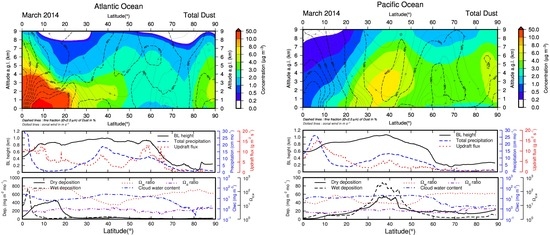An Evaluation of the CHIMERE Chemistry Transport Model to Simulate Dust Outbreaks across the Northern Hemisphere in March 2014
Abstract
:1. Introduction
2. Experiments
2.1. Modeling Tools
2.1.1. The Chemistry Transport Model CHIMERE
2.1.2. Model Set-Up
2.2. Dust Emission in CHIMERE
2.3. Observational Data for the Evaluation of Model Performances
- CALIPSO and CloudSat, launched in 2006 as part of NASA’s A-train satellite constellation, provide detailed information on cloud and aerosol vertical profiles from tropics to the poles. Cloud vertical profiles are derived from Cloud-Aerosol Lidar with Orthogonal Polarization (CALIOP) [78]. Here, we use the V4.10 dataset [79], cross section of the atmosphere provides various categories separating mineral dust from anthropogenic pollution. The list of selected orbits is given in Figure 2.
- MODIS (Moderate Resolution Imaging Spectroradiometer) is a key instrument aboard the Terra (originally known as EOS AM-1) and Aqua (originally known as EOS PM-1) satellites. Terra’s orbit around the Earth is timed so that it passes from north to south across the equator in the morning, while Aqua passes south to north over the equator in the afternoon. Terra MODIS and Aqua MODIS are viewing the entire Earth’s surface every 1–2 days, acquiring data in 36 spectral bands, or groups of wavelengths. The MODIS Aerosol Product monitors the ambient aerosol optical thickness over the oceans globally and over the continents. Furthermore, the aerosol size distribution is derived over the oceans, and the aerosol type is derived over the continents. “Fine” aerosols (anthropogenic/pollution) and “course” aerosols (natural particles; e.g., dust) are also derived [80,81]. MODIS products are downloaded from the Worldview tool developed by NASA accessible at https://worldview.earthdata.nasa.gov/. In this paper, the merged Dark Target/Deep Blue Aerosol Optical Depth product will be used. It provides a more global, synoptic view of aerosol optical depth over land and ocean. This layer is created from three algorithms: two “Dark Target” (DT) algorithms for retrieving: (1) over ocean (dark in visible and longer wavelengths); and (2) over vegetated/dark-soiled land (dark in the visible); and the Deep Blue (DB) algorithm, originally developed for retrieving (3) over desert/arid land (bright in the visible wavelengths). Which algorithm is used for a particular location on the Earth depends on its surface cover.
- The MISR (Multi-angle Imaging SpectroRadiometer) Aerosol Optical Depth Average layer product is also used. This instrument on board Terra displays the temporal averages of all aerosol optical depths calculated from radiances acquired from the green band (555 nm) of MISR’s cameras as an average value for March 2014. This instrument is aboard the Terra satellite.
- Atmospheric composition data from the US IMPROVE network are also available with PM2.5, PM10 and Soil PM concentrations based on calcium measurements [82]. Daily data are available every three days and available at http://vista.cira.colostate.edu/Improve/improve-data/.
- Air quality data from the US EPA (Environmental Protection Agency) network provides hourly PM2.5 concentrations accessible at https://www.epa.gov/outdoor-air-quality-data.
- Data from the Chinese network provides hourly PM10 and PM2.5 concentrations made available for the Beijing area.
- The French GEOD’AIR database provides PM10 and PM2.5 concentrations for some stations over the French Caribbean Islands in this study (Available online: https://www.geodair.fr/).
- The modeled daytime Aerosol Optical Depth (AOD) is compared to observations from the AERONET network [85], available at https://aeronet.gsfc.nasa.gov from the daily AERONET level-2 measurements AERONET-AOD at 870 nm. Unfortunately, AERONET measurements can be used in clear sky conditions areas generally below 20° N in latitude over the Northern Hemisphere, while the model can simulate the AOD for all types of sky. For Europe [86], Central Asia or North America, most dust outbreaks are issued from low-pressure systems and then imply cloudy conditions that makes impossible to use level 2 AERONET products to detect these episodes since most of data are ruled out due to clouds.
- Synoptic data called SYNOP from the World Meteorological Organization (WMO) provide reporting weather observations made by manned and automated weather stations. The following ten types of coded data have been selected to identify observed dust episodes: “widespread dust in suspension not raised by wind”, “dust or sand raised by wind”, “well developed dust or sand whirls”, “dust or sand storm within sight but not at station”, “slight to moderate dust storm decreasing in intensity”, “slight to moderate dust storm, no change”, “slight to moderate dust storm, increasing in intensity”, “severe dust storm, decreasing in intensity”, “severe dust storm, no change”, and “severe dust storm, increasing in intensity”. The categories “Haze” and “Smoke” have not been considered. These observations remain subjective as they are man-based observations: they can be mixed-up with anthropogenic, wildfires pollution, or misty and foggy conditions, but, in some locations, such as in Central Asia, this information is the only one we can access.
- Additional data from isolated stations or issued from previous publications will be used to assess the model performances.
3. Discussion Results at the Hemispheric Scale
3.1. Overview of PM Concentrations Simulated by CHIMERE over the Northern Hemisphere in March 2014
3.2. Particle Size Distribution
3.3. Deposition of Mineral Dust in March 2014
3.4. Transport of Mineral Dust Simulated by CHIMERE in March 2014
4. Discussion on Regional Dust Events
4.1. Dust Outbreaks over North America
4.2. Dust Outbreaks in Europe
4.3. Dust Outbreaks over the Caribbean Areas
4.4. Dust Outbreaks in Central Asia
4.5. Dust Outbreaks over China
5. Conclusions
Supplementary Materials
Acknowledgments
Author Contributions
Conflicts of Interest
References
- WHO Regional Office for Europe, OECD. Economic Cost of the Health Impact of Air Pollution in Europe: Clean Air, Health and Wealth; WHO Regional Office for Europe: Copenhagen, Denmark, 2015. [Google Scholar]
- Ding, L.; Zhu, D.; Peng, D.; Zhao, Y. Air pollution and asthma attacks in children: A case–crossover analysis in the city of Chongqing, China. Environ. Pollut. 2017, 220, 348–353. [Google Scholar] [CrossRef] [PubMed]
- Briant, R.; Tuccella, P.; Deroubaix, A.; Khvorostyanov, D.; Menut, L.; Mailler, S.; Turquety, S. Aerosol-radiation interaction modeling using online coupling between the WRF 3.7.1 meteorological model and the CHIMERE 2016 chemistry-transport model, through the OASIS3-MCT coupler. Geosci. Model Dev. 2017, 10, 927–944. [Google Scholar] [CrossRef]
- Weinzierl, B.; Ansmann, A.; Prospero, J.M.; Althausen, D.; Benker, N.; Chouza, F.; Dollner, M.; Farrell, D.; Fomba, W.K.; Freudenthaler, V.; et al. The Saharan Aerosol Long-range TRansport and Aerosol Cloud Interaction Experiment (SALTRACE): Overview and selected highlights. Bull. Am. Meteorol. Soc. 2017, 98, 1428–1451. [Google Scholar] [CrossRef]
- Fuzzi, S.; Baltensperger, U.; Carslaw, K.; Decesari, S.; Denier van der Gon, H.; Facchini, M.C.; Fowler, D.; Koren, I.; Langford, B.; Lohmann, U.; et al. Particulate matter, air quality and climate: Lessons learned and future needs. Atmos. Chem. Phys. 2015, 15, 8217–8299. [Google Scholar] [CrossRef] [Green Version]
- Middleton, N.J. Desert dust hazards: A global review. Aeolian Res. 2017, 24, 53–63. [Google Scholar] [CrossRef]
- Bessagnet, B.; Menut, L.; Aymoz, G.; Chepfer, H.; Vautard, R. Modeling dust emissions and transport within Europe: The Ukraine March 2007 event. J. Geophys. Res. 2008, 113, D15202. [Google Scholar] [CrossRef]
- Pérez García-Pando, C.; Stanton, M.C.; Diggle, P.J.; Trzaska, S.; Miller, R.L.; Perlwitz, J.P.; Baldasano, J.M.; Cuevas, E.; Ceccato, P.; Yaka, P.; et al. Soil dust aerosols and wind as predictors of seasonal meningitis incidence in Niger. Environ. Health Perspect. 2014, 122, 679–686. [Google Scholar] [CrossRef] [PubMed]
- Ghio, A.J.; Kummarapurugu, S.T.; Tong, H.; Soukup, J.M.; Dailey, L.A.; Boykin, E.; Gilmour, M.I.; Ingram, P.; Roggli, V.L.; Goldstein, H.L.; et al. Biological effects of desert dust in respiratory epithelial cells and a murine model. Inhal. Toxicol. 2014, 26, 299–309. [Google Scholar] [CrossRef] [PubMed]
- Jusot, J.-F.; Neill, D.R.; Waters, E.M.; Bangert, M.; Collins, M.; Bricio Moreno, L.; Lawan, K.G.; Moussa Moussa, M.; Dearing, E.; Everett, D.B.; et al. Airborne dust and high temperatures are risk factors for invasive bacterial disease. J. Allergy Clin. Immunol. 2017, 139, 977–986.e2. [Google Scholar] [CrossRef] [PubMed]
- Stafoggia, M.; Zauli-Sajani, S.; Pey, J.; Samoli, E.; Alessandrini, E.; Basagaña, X.; Cernigliaro, A.; Chiusolo, M.; Demaria, M.; Díaz, J.; et al. Desert dust outbreaks in Southern Europe: Contribution to daily PM10 concentrations and short-term associations with mortality and hospital admissions. Environ. Health Perspect. 2016, 124, 413–419. [Google Scholar] [CrossRef] [PubMed]
- Kanatani, K.T.; Ito, I.; Al-Delaimy, W.K.; Adachi, Y.; Mathews, W.C.; Ramsdell, J.W. Desert dust exposure is associated with increased risk of asthma hospitalization in children. Am. J. Respir. Crit. Care Med. 2010, 182, 1475–1481. [Google Scholar] [CrossRef] [PubMed]
- Yoo, Y.; Choung, J.T.; Yu, J.; Kim, D.K.; Koh, Y.Y. Acute effects of Asian dust events on respiratory symptoms and peak expiratory flow in children with mild asthma. J. Korean Med. Sci. 2008, 23, 66–71. [Google Scholar] [CrossRef] [PubMed]
- Thalib, L.; Al-Taiar, A. Dust storms and the risk of asthma admissions to hospitals in Kuwait. Sci. Total Environ. 2012, 433, 347–351. [Google Scholar] [CrossRef] [PubMed]
- Wang, C.-H.; Chen, C.-S.; Lin, C.-L. The threat of Asian dust storms on asthma patients: A population-based study in Taiwan. Glob. Public Health 2014, 9, 1040–1052. [Google Scholar] [CrossRef] [PubMed]
- Perez, L.; Tobias, A.; Querol, X.; Kunzli, N.; Pey, J.; Alastuey, A.; Viana, M.; Valero, N.; Gonzalez-Cabre, M.; Sunyer, J. Coarse particles from Saharan dust and daily mortality. Epidemiology 2008, 19, 800–807. [Google Scholar] [CrossRef] [PubMed]
- UNEP, WMO, UNCCD Global Assessment of Sand and Dust Storms. United Nations Environment Programme, Nairobi. 2016. Available online: http://www.unep.org/publications (accessed on 17 August 2017).
- Marinou, E.; Amiridis, V.; Binietoglou, I.; Tsikerdekis, A.; Solomos, S.; Proestakis, E.; Konsta, D.; Papagiannopoulos, N.; Tsekeri, A.; Vlastou, G.; et al. Three-dimensional evolution of Saharan dust transport towards Europe based on a 9-year EARLINET-optimized CALIPSO dataset. Atmos. Chem. Phys. 2017, 17, 5893–5919. [Google Scholar] [CrossRef]
- Barnaba, F.; Bolignano, A.; Di Liberto, L.; Morelli, M.; Lucarelli, F.; Nava, S.; Perrino, C.; Canepari, S.; Basart, S.; Costabile, F.; et al. Desert dust contribution to PM10 loads in Italy: Methods and recommendations addressing the relevant European Commission Guidelines in support to the Air Quality Directive 2008/50. Atmos. Environ. 2017, 161, 288–305. [Google Scholar] [CrossRef]
- Tong, D.Q.; Dan, M.; Wang, T.; Lee, P. Long-term dust climatology in the western United States reconstructed from routine aerosol, ground monitoring. Atmos. Chem. Phys. 2012, 12, 5189–5205. [Google Scholar] [CrossRef]
- Tong, D.Q.; Wang, J.X.L.; Gill, T.E.; Lei, H.; Wang, B. Intensified dust storm activity and Valley fever infection in the southwestern United States. Geophys. Res. Lett. 2017, 44, 4304–4312. [Google Scholar] [CrossRef]
- Tagliabue, A.; Bowie, A.R.; Boyd, P.W.; Buck, K.N.; Johnson, K.S.; Saito, M.A. The integral role of iron in ocean biogeochemistry. Nature 2017, 543, 51–59. [Google Scholar] [CrossRef] [PubMed]
- Herut, B.; Rahav, E.; Tsagaraki, T.M.; Giannakourou, A.; Tsiola, A.; Psarra, S.; Lagaria, A.; Papageorgiou, N.; Mihalopoulos, N.; Theodosi, C.N.; et al. The Potential Impact of Saharan Dust and Polluted Aerosols on Microbial Populations in the East Mediterranean Sea, an Overview of a Mesocosm Experimental Approach. Front. Mar. Sci. 2016, 3, 226. [Google Scholar] [CrossRef]
- Tozer, P.; Leys, J. Dust storms—What do they really cost? Rangel. J. 2013, 35, 131–142. [Google Scholar] [CrossRef]
- Huneeus, N.; Basart, S.; Fiedler, S.; Morcrette, J.-J.; Benedetti, A.; Mulcahy, J.; Terradellas, E.; Pérez García-Pando, C.; Pejanovic, G.; Nickovic, S.; et al. Forecasting the Northern African dust outbreak towards Europe in April 2011: A model intercomparison. Atmos. Chem. Phys. 2016, 16, 4967–4986. [Google Scholar] [CrossRef] [Green Version]
- Lu, C.-H.; da Silva, A.; Wang, J.; Moorthi, S.; Chin, M.; Colarco, P.; Tang, Y.; Bhattacharjee, P.S.; Chen, S.-P.; Chuang, H.-Y.; et al. The implementation of NEMS GFS Aerosol Component (NGAC) Version 1.0 for global dust forecasting at NOAA/NCEP. Geosci. Model Dev. 2016, 9, 1905–1919. [Google Scholar] [CrossRef]
- Sessions, W.R.; Reid, J.S.; Benedetti, A.; Colarco, P.R.; da Silva, A.; Lu, S.; Sekiyama, T.; Tanaka, T.Y.; Baldasano, J.M.; Basart, S.; et al. Development towards a global operational aerosol consensus: Basic climatological characteristics of the International Cooperative for Aerosol Prediction Multi-Model Ensemble (ICAP-MME). Atmos. Chem. Phys. 2015, 15, 335–362. [Google Scholar] [CrossRef]
- Rouïl, L.; Honoré, C.; Vautard, R.; Beekmann, M.; Bessagnet, B.; Malherbe, L.; Meleux, F.; Dufour, A.; Elichegaray, C.; Flaud, J.-M.; et al. PREV’AIR: An operational forecasting and mapping system for air quality in Europe. Bull. Am. Meteorol. Soc. 2009. [Google Scholar] [CrossRef]
- Colette, A.; Bessagnet, B.; Meleux, F.; Terrenoire, E.; Rouïl, L. Frontiers in air quality modeling. Geosci. Model Dev. 2014, 7, 203–210. [Google Scholar] [CrossRef] [Green Version]
- Bessagnet, B.; Beauchamp, M.; Guerreiro, C.; de Leeuw, F.; Tsyro, S.; Colette, A.; van Aardenne, J. Can further mitigation of ammonia emissions reduce exceedances of particulate matter air quality standards? Environ. Sci. Policy 2014, 44, 149–163. [Google Scholar] [CrossRef]
- Colette, A.; Bessagnet, B.; Vautard, R.; Szopa, S.; Rao, S.; Schucht, S.; Klimont, Z.; Menut, L.; Clain, G.; Meleux, F.; et al. European atmosphere in 2050, a regional air quality and climate perspective under CMIP5 scenarios. Atmos. Chem. Phys. 2013, 13, 7451–7471. [Google Scholar] [CrossRef] [Green Version]
- Lin, M.; Holloway, T.; Oki, T.; Streets, D.G.; Richter, A. Multiscale model analysis of boundary layer ozone over East Asia. Atmos. Chem. Phys. 2009, 9, 3277–3301. [Google Scholar] [CrossRef]
- Klich, C.A.; Fuelberg, H.E. The role of horizontal model resolution in assessing the transport of CO in a middle latitude cyclone using WRF-Chem. Atmos. Chem. Phys. 2014, 14, 609–627. [Google Scholar] [CrossRef]
- Ma, P.-L.; Rasch, P.J.; Fast, J.D.; Easter, R.C.; Gustafson, W.I., Jr.; Liu, X.; Ghan, S.J.; Singh, B. Assessing the CAM5 physics suite in the WRF-Chem model: Implementation, resolution sensitivity, and a first evaluation for a regional case study. Geosci. Model Dev. 2014, 7, 755–778. [Google Scholar] [CrossRef]
- Basart, S.; Vendrell, L.; Baldasano, J.M. High-resolution dust modeling over complex terrains in West Asia. Aeolian Res. 2016, 23, 37–50. [Google Scholar] [CrossRef]
- Yu, M.; Yang, C. Improving the Non-Hydrostatic Numerical Dust Model by Integrating Soil Moisture and Greenness Vegetation Fraction Data with Different Spatiotemporal Resolutions. PLoS ONE 2016, 11. [Google Scholar] [CrossRef] [PubMed]
- Kocha, C.; Lafore, J.-P.; Tulet, P.; Seity, Y. High-resolution simulation of a major West African dust-storm: Comparison with observations and investigation of dust impact. Q. J. R. Meteorol. Soc. 2012, 138, 455–470. [Google Scholar] [CrossRef]
- Kalenderski, S.; Stenchikov, G. High-resolution regional modeling of summertime transport and impact of African dust over the Red Sea and Arabian Peninsula. J. Geophys. Res. Atmos. 2016, 121, 6435–6458. [Google Scholar] [CrossRef]
- Menut, L. Sensitivity of hourly Saharan dust emissions to NCEP and ECMWF modeled wind speed. J. Geophys. Res. Atmos. 2008, 113, D16201. [Google Scholar] [CrossRef]
- Zhang, K.; Zhao, C.; Wan, H.; Qian, Y.; Easter, R.C.; Ghan, S.J.; Sakaguchi, K.; Liu, X. Quantifying the impact of sub-grid surface wind variability on sea salt and dust emissions in CAM5. Geosci. Model Dev. 2016, 9, 607–632. [Google Scholar] [CrossRef]
- McKendry, I.G.; Strawbridge, K.B.; O’Neill, N.T.; Macdonald, A.M.; Liu, P.S.K.; Leaitch, W.R.; Anlauf, K.G.; Jaegle, L.; Fairlie, T.D.; Westphal, D.L. Trans-Pacific transport of Saharan dust to western North America: A case study. J. Geophys. Res. 2007, 112, D01103. [Google Scholar] [CrossRef]
- Teixeira, J.C.; Carvalho, A.C.; Tuccella, P.; Curci, G.; Rocha, A. WRF-chem sensitivity to vertical resolution during a saharan dust event. Phys. Chem. Earth 2016, 94, 188–195. [Google Scholar] [CrossRef]
- Schaap, M.; Cuvelier, C.; Hendriks, C.; Bessagnet, B.; Baldasano, J.M.; Colette, A.; Thunis, P.; Karam, D.; Fagerli, H.; Graff, A.; et al. Performance of European chemistry transport models as function of horizontal resolution. Atmos. Environ. 2015, 112, 90–105. [Google Scholar] [CrossRef] [Green Version]
- Valari, M.; Menut, L. Does increase in air quality models resolution bring surface ozone concentrations closer to reality? J. Atmos. Ocean. Technol. 2008, 25, 1955–1968. [Google Scholar] [CrossRef]
- Reynolds, R.L.; Munson, S.M.; Fernandez, D.; Goldstein, H.L.; Neff, J.C. Concentrations of mineral aerosol from desert to plains across the central Rocky Mountains, western United States. Aeolian Res. 2016, 23, 21–35. [Google Scholar] [CrossRef]
- Mailler, S.; Menut, L.; Khvorostyanov, D.; Valari, M.; Couvidat, F.; Siour, G.; Turquety, S.; Briant, R.; Tuccella, P.; Bessagnet, B.; et al. CHIMERE-2017: From urban to hemispheric chemistry-transport modeling. Geosci. Model Dev. 2017, 10, 2397–2423. [Google Scholar] [CrossRef]
- Werner, M.; Tegen, I.; Harrison, S.P.; Kohfeld, K.E.; Prentice, I.C.; Balkanski, Y.; Rodhe, H.; Roelandt, C. Seasonal and interannual variability of the mineral dust cycle under present and glacial climate conditions. J. Geophys. Res. 2002. [Google Scholar] [CrossRef]
- Menut, L.; Bessagnet, B.; Khvorostyanov, D.; Beekmann, M.; Blond, N.; Colette, A.; Coll, I.; Curci, G.; Foret, G.; Hodzic, A.; et al. CHIMERE 2013: A model for regional atmospheric composition modeling. Geosci. Model Dev. 2013, 6, 981–1028. [Google Scholar] [CrossRef] [Green Version]
- Cuvelier, C.; Thunis, P.; Vautard, R.; Amann, M.; Bessagnet, B.; Bedogni, M.; Berkowicz, R.; Brandt, J.; Brocheton, F.; Builtjes, P.; et al. CityDelta A model intercomparison study to explore the impact of emission reductions in European cities in 2010. Atmos. Environ. 2007, 41, 189–207. [Google Scholar] [CrossRef]
- Van Loon, M.; Vautard, R.; Schaap, M.; Bergström, R.; Bessagnet, B.; Brandt, J.; Builtjes, P.J.H.; Christensen, J.H.; Cuvelier, C.; Graff, A.; et al. Evaluation of long-term ozone simulations from seven regional air quality models and their ensemble. Atmos. Environ. 2007, 41, 2083–2097. [Google Scholar] [CrossRef]
- Vautard, R.; Schaap, M.; Bergstrom, R.; Bessagnet, B.; Brandt, J.; Builtjes, P.J.H.; Christensen, J.H.; Cuvelier, C.; Foltescu, V.; Graff, A.; et al. Skill and uncertainty of a regional air quality model ensemble. Atmos. Environ. 2009, 43, 4822–4832. [Google Scholar] [CrossRef]
- Colette, A.; Granier, C.; Hodnebrog, Ø.; Jakobs, H.; Maurizi, A.; Nyiri, A.; Bessagnet, B.; D’Angiola, A.; D’Isidoro, M.; Gauss, M.; et al. Air quality trends in Europe over the past decade: A first multi-model assessment. Atmos. Chem. Phys. 2011, 11, 11657–11678. [Google Scholar] [CrossRef] [Green Version]
- Galmarini, S.; Rao, S.T.; Steyn, D.G. Preface. Atmos. Environ. 2012, 53, 1–3. [Google Scholar] [CrossRef]
- Bessagnet, B.; Pirovano, G.; Mircea, M.; Cuvelier, C.; Aulinger, A.; Calori, G.; Ciarelli, G.; Manders, A.; Stern, R.; Tsyro, S.; et al. Presentation of the EURODELTA III intercomparison exercise—Evaluation of the chemistry transport models’ performance on criteria pollutants and joint analysis with meteorology. Atmos. Chem. Phys. 2016, 16, 12667–12701. [Google Scholar] [CrossRef]
- Terrenoire, E.; Bessagnet, B.; Rouïl, L.; Tognet, F.; Pirovano, G.; Létinois, L.; Beauchamp, M.; Colette, A.; Thunis, P.; Amann, M.; et al. High-resolution air quality simulation over Europe with the chemistry transport model CHIMERE. Geosci. Model Dev. 2015, 8, 21–42. [Google Scholar] [CrossRef] [Green Version]
- Nenes, A.; Pilinis, C.; Pandis, S. ISORROPIA: A new thermodynamic model for inorganic multicomponent atmospheric aerosols. Aquatic Geochem. 1998, 4, 123–152. [Google Scholar] [CrossRef]
- Semmler, M.; Luo, B.P.; Koop, T. Densities of liquid H+/NH4+/SO42−/NO3−/H2O solutions at tropospheric temperatures. Atmos. Environ. 2006, 40, 467–483. [Google Scholar] [CrossRef]
- Folberth, G.A.; Hauglustaine, D.A.; Lathière, J.; Brocheton, F. Interactive chemistry in the Laboratoire de Météorologie Dynamique general circulation model: Model description and impact analysis of biogenic hydrocarbons on tropospheric chemistry. Atmos. Chem. Phys. 2006, 6, 2273–2319. [Google Scholar] [CrossRef]
- Hauglustaine, D.A.; Hourdin, F.; Jourdain, L.; Filiberti, M.A.; Walters, S.; Lamarque, J.-F.; Holland, E.A. Interactive chemistry in the Laboratoire de Météorologie Dynamique general circulation model: Description and background tropospheric chemistry evaluation. J. Geophys. Res. 2004. [Google Scholar] [CrossRef]
- Crippa, M.; Janssens-Maenhout, G.; Dentener, F.; Guizzardi, D.; Sindelarova, K.; Muntean, M.; Van Dingenen, R.; Granier, C. Forty years of improvements in European air quality: Regional policy-industry interactions with global impacts. Atmos. Chem. Phys. 2016, 16, 3825–3841. [Google Scholar] [CrossRef] [Green Version]
- Janssens-Maenhout, G.; Crippa, M.; Guizzardi, D.; Dentener, F.; Muntean, M.; Pouliot, G.; Keating, T.; Zhang, Q.; Kurokawa, J.; Wankmüller, R.; et al. HTAP_v2.2: A mosaic of regional and global emission grid maps for 2008 and 2010 to study hemispheric transport of air pollution. Atmos. Chem. Phys. 2015, 15, 11411–11432. [Google Scholar] [CrossRef] [Green Version]
- EC, European Commission, Joint Research Centre (JRC)/Netherlands Environmental Assessment Agency (PBL). Emission Database for Global Atmospheric Research (EDGAR), Release Version 4.3.1. 2016. Available online: http://edgar.jrc.ec.europa.eu/overview.php?v=431 (accessed on 10 August 2017).
- Stromatas, S.; Turquety, S.; Menut, L.; Chepfer, H.; Péré, J.C.; Cesana, G.; Bessagnet, B. Lidar signal simulation for the evaluation of aerosols in chemistry transport models. Geosci. Model Dev. 2012, 5, 1543–1564. [Google Scholar] [CrossRef] [Green Version]
- Menut, L.; Perez Garcia-Pando, C.; Haustein, K.; Bessagnet, B.; Prigent, C.; Alfaro, S. Relative impact of roughness and soil texture on mineral dust emission fluxes modeling. J. Geophys. Res. 2013, 118, 6505–6520. [Google Scholar]
- Kok, J.F.; Albani, S.; Mahowald, N.M.; Ward, D.S. An im-proved dust emission model—Part 2: Evaluation in the Com-munity Earth System Model, with implications for the use of dust source functions. Atmos. Chem. Phys. 2014, 14, 13043–13061. [Google Scholar] [CrossRef]
- Kok, J.F.; Mahowald, N.M.; Fratini, G.; Gillies, J.A.; Ishizuka, M.; Leys, J.F.; Mikami, M.; Park, M.-S.; Park, S.-U.; Van Pelt, R.S.; et al. An improved dust emission model—Part 1: Model description and comparison against measurements. Atmos. Chem. Phys. 2014, 14, 13023–13041. [Google Scholar] [CrossRef]
- Marticorena, B.; Bergametti, G. Modeling the atmospheric dust cycle: 1-Design a soil-derived dust emissions scheme. J. Geophys. Res. 1995, 100, 16415–16430. [Google Scholar] [CrossRef]
- Alfaro, S.C.; Gomes, L. Modeling mineral aerosol production by wind erosion: Emission intensities and aerosol size distributions in source areas. J. Geophys. Res. Atmos. 2001, 106, 18075–18084. [Google Scholar] [CrossRef]
- Shao, Y.; Lu, I. A simple expression for wind erosion threshold friction velocity. J. Geophys. Res. 2000, 105, 22437–22443. [Google Scholar] [CrossRef]
- Iversen, J.D.; White, B.R. Saltation threshold on Earth, Mars and Venus. Sedimentology 1982, 29, 111–119. [Google Scholar] [CrossRef]
- Menut, L.; Schmechtig, C.; Marticorena, B. Sensitivity of the sandblasting fluxes calculations to the soil size distribution accuracy. J. Atmos. Ocean. Technol. 2005, 22, 1875–1884. [Google Scholar] [CrossRef]
- Homer, C.; Huang, C.; Yang, L.; Wylie, B.; Coan, M. Development of a 2001 National Landcover Database for the United States. Photogramm. Eng. Remote Sens. 2004, 70, 829–840. [Google Scholar] [CrossRef]
- Wolock, D. State Soil Geographic (STATSGO) Data Base—Data Use Information; Technical Report; US Department of Agriculture: Washington, DC, USA, 1994.
- Prigent, C.; Jiménez, C.; Catherinot, J. Comparison of satellite microwave backscattering (ASCAT) and visible/near-infrared reflectances (PARASOL) for the estimation of aeolian aerodynamic roughness length in arid and semi-arid regions. Atmos. Meas. Tech. 2012, 5, 2703–2712. [Google Scholar] [CrossRef] [Green Version]
- Beegum, S.N.; Gherboudj, I.; Chaouch, N.; Couvidat, F.; Menut, L.; Ghedira, H. Simulating Aerosols over Arabian Peninsula with CHIMERE: Sensitivity to soil, surface parameters and anthropogenic emission inventories. Atmos. Environ. 2016, 128, 185–197. [Google Scholar] [CrossRef]
- Fecan, F.; Marticorena, B.; Bergametti, G. Parameterization of the increase of aeolian erosion threshold wind friction velocity due to soil moisture for arid and semi-arid areas. Ann. Geophys. 1999, 17, 149–157. [Google Scholar] [CrossRef]
- Bullard, J.E.; Baddock, M.; Bradwell, T.; Crusius, J.; Darlington, E.; Gaiero, D.; Gassó, S.; Gisladottir, G.; Hodgkins, R.; McCulloch, R.; et al. High Latitude Dust in the Earth System. Rev. Geophys. 2016, 54, 447–485. [Google Scholar] [CrossRef]
- Hunt, W.H.; Winker, D.M.; Vaughan, M.A.; Powell, K.A.; Lucker, P.L.; Weimer, C. CALIPSO lidar description and performance assessment. J. Atmos. Ocean. Technol. 2009, 26, 1214–1228. [Google Scholar] [CrossRef]
- CALIPSO Science Team. CALIPSO/CALIOP Level 2, Vertical Feature Mask Data, Version 4.10; NASA Atmospheric Science Data Center (ASDC): Hampton, VA, USA, 2016.
- Levy, R.C.; Mattoo, S.; Munchak, L.A.; Remer, L.A.; Sayer, A.M.; Patadia, F.; Hsu, N.C. The Collection 6 MODIS aerosol products over land and ocean. Atmos. Meas. Tech. 2013, 6, 2989–3034. [Google Scholar] [CrossRef]
- Levy, R.; Hsu, C. MODIS Atmosphere L2 Aerosol Product. NASA MODIS Adaptive Processing System; Goddard Space Flight Center: Greenbelt, MD, USA, 2015.
- Malm, W.C.; Sisler, J.F.; Huffman, D.; Eldred, R.A.; Cahill, T.A. Spatial and seasonal trends in particle concentration and optical extinction in the United States. J. Geophys. Res. 1994, 99, 1347–1370. [Google Scholar] [CrossRef]
- Tørseth, K.; Aas, W.; Breivik, K.; Fjæraa, A.M.; Fiebig, M.; Hjellbrekke, A.G.; Lund Myhre, C.; Solberg, S.; Yttri, K.E. Introduction to the European Monitoring and Evaluation Programme (EMEP) and observed atmospheric composition change during 1972–2009. Atmos. Chem. Phys. 2012, 12, 5447–5481. [Google Scholar] [CrossRef] [Green Version]
- Guinot, B.; Cachier, H.; Oikonomou, K. Geochemical perspectives from a new aerosol chemical mass closure. Atmos. Chem. Phys. 2007, 7, 1657–1670. [Google Scholar] [CrossRef]
- Holben, B.N.; Eck, T.F.; Slutsker, I.; Tanre, D.; Buis, J.P.; Setzer, A.; Vermote, E.; Reagan, J.A.; Kaufman, Y.J.; Nakajima, T.; et al. AERONET—A federated instrument network and data archive for aerosol characterization. Remote Sens. Environ. 1998, 66, 1–16. [Google Scholar] [CrossRef]
- Gaetani, M.; Pasqui, M. Synoptic patterns associated with extreme dust events in the Mediterranean Basin. Reg. Environ. Chang. 2014, 1847–1860. [Google Scholar] [CrossRef]
- Vieno, M.; Heal, M.R.; Twigg, M.M.; MacKenzie, I.A.; Braban, C.F.; Lingard, J.J.N.; Ritchie, S.; Beck, R.C.; Móring, A.; Ots, R.; et al. The UK particulate matter air pollution episode of March–April 2014, more than Saharan dust. Environ. Res. Lett. 2016, 11. [Google Scholar] [CrossRef]
- Savoie, D.L.; Prospero, J.M. Aerosol Concentration Statistics for Northern Tropical Atlantic. J. Geophys. Res. 1977, 82, 5954–5964. [Google Scholar] [CrossRef]
- Fan, T.; Toon, O.B. Modeling sea-salt aerosol in a coupled climate and sectional microphysical model: Mass, optical depth and number concentration. Atmos. Chem. Phys. 2011, 11, 4587–4610. [Google Scholar] [CrossRef] [Green Version]
- Shao, Y.; Klose, M.; Wyrwoll, K.-H. Recent global dust trend and connections to climate forcing. J. Geophys. Res. Atmos. 2013, 118. [Google Scholar] [CrossRef]
- Prospero, J.M.; Uematsu, M.; Savoie, D.L. SEAREX: The Sea/Air Exchange Program, Mineral aerosol transport to the Pacific Ocean. In Chemical Oceanography; Duce, R.A., Ed.; Academic Press: San Diego, CA, USA, 1989; Volume 10, pp. 188–218. ISBN 0-12-588610-1. [Google Scholar]
- Luo, C.; Mahowald, N.M.; del Corral, J. Sensitivity study of meteorological parameters on mineral aerosol mobilization, transport, and distribution. J. Geophys. Res. 2003, 108, 4447. [Google Scholar] [CrossRef]
- Uematsu, M.; Duce, R.A.; Prospero, J.M.; Chen, L.Q.; Merrill, J.T. Transport of mineral aerosol from Asia to the North Pacific Ocean. J. Geophys. Res. 1983, 88, 5343–5352. [Google Scholar] [CrossRef]
- Huneeus, N.; Schulz, M.; Balkanski, Y.; Griesfeller, J.; Prospero, J.; Kinne, S.; Bauer, S.; Boucher, O.; Chin, M.; Dentener, F.; et al. Global dust model intercomparison in AeroCom phase I. Atmos. Chem. Phys. 2011, 11, 7781–7816. [Google Scholar] [CrossRef] [Green Version]
- Horowitz, H.M.; Garland, R.M.; Thatcher, M.; Landman, W.A.; Dedekind, Z.; van der Merwe, J.; Engelbrecht, F.A. Evaluation of climate model aerosol seasonal and spatial variability over Africa using AERONET. Atmos. Chem. Phys. 2017, 17, 13999–14023. [Google Scholar] [CrossRef]
- Reddington, C.L.; McMeeking, G.; Mann, G.W.; Coe, H.; Frontoso, M.G.; Liu, D.; Flynn, M.; Spracklen, D.V.; Carslaw, K.S. The mass and number size distributions of black carbon aerosol over Europe. Atmos. Chem. Phys. 2013, 13, 4917–4939. [Google Scholar] [CrossRef]
- Tsai, J.-H.; Chang, K.-L.; Lin, J.J.; Lin, Y.-H.; Chiang, H.-L. Mass-Size Distributions of Particulate Sulfate, Nitrate, and Ammonium in a Particulate Matter Nonattainment Region in Southern Taiwan. J. Air Waste Manag. Assoc. 2005, 55, 502–509. [Google Scholar] [CrossRef] [PubMed]
- Hazi, Y.; Heikkinen, M.S.A.; Cohen, B.S. Size distribution of acidic sulfate ions in fine ambient particulate matter and assessment of source region effect. Atmos. Environ. 2003, 37, 5403–5413. [Google Scholar] [CrossRef]
- Li, M.; Wang, T.; Han, Y.; Xie, M.; Li, S.; Zhuang, B.; Chen, P. Modeling of a severe dust event and its impacts on ozone photochemistry over the downstream Nanjing megacity of eastern China. Atmos. Environ. 2017, 160, 107–123. [Google Scholar] [CrossRef]
- Hand, V.L.; Capes, G.; Vaughan, D.J.; Formenti, P.; Haywood, J.M.; Coe, H. Evidence of internal mixing of African dust and biomass burning particles by individual particle analysis using electron beam techniques. J. Geophys. Res. 2010, 115, D13301. [Google Scholar] [CrossRef]
- Pan, X.; Uno, I.; Wang, Z.; Nishizawa, T.; Sugimoto, N.; Yamamoto, S.; Kobayashi, H.; Sun, Y.; Fu, P.; Tang, X.; et al. Real-time observational evidence of changing Asian dust morphology with the mixing of heavy anthropogenic pollution. Sci. Rep. 2017, 7, 335. [Google Scholar] [CrossRef] [PubMed]
- Jeong, G.Y.; Kim, J.Y.; Seo, J.; Kim, G.M.; Jin, H.C.; Chun, Y. Long-range transport of giant particles in Asian dust identified by physical, mineralogical, and meteorological analysis. Atmos. Chem. Phys. 2014, 14, 505–521. [Google Scholar] [CrossRef]
- Rittmeister, F.; Ansmann, A.; Engelmann, R.; Skupin, A.; Baars, H.; Kanitz, T.; Kinne, S. Profiling of Saharan dust from the Caribbean to western Africa—Part 1: Layering structures and optical properties from shipborne polarization/Raman lidar observations. Atmos. Chem. Phys. 2017, 17, 12963–12983. [Google Scholar] [CrossRef]
- Kipling, Z.; Stier, P.; Johnson, C.E.; Mann, G.W.; Bellouin, N.; Bauer, S.E.; Bergman, T.; Chin, M.; Diehl, T.; Ghan, S.J.; et al. What controls the vertical distribution of aerosol? Relationships between process sensitivity in HadGEM3–UKCA and inter-model variation from AeroCom Phase II. Atmos. Chem. Phys. 2016, 16, 2221–2241. [Google Scholar] [CrossRef]
- Mahowald, N.M.; Baker, A.R.; Bergametti, G.; Brooks, N.; Duce, R.A.; Jickells, T.D.; Kubilay, N.; Prospero, J.M.; Tegen, I. Atmospheric global dust cycle and iron inputs to the ocean. Glob. Biogeochem. 2005, 19, GB4025. [Google Scholar] [CrossRef]
- Nagare, B.; Marcolli, C.; Stetzer, O.; Lohmann, U. Comparison of measured and calculated collision efficiencies at low temperatures. Atmos. Chem. Phys. 2015, 15, 13759–13776. [Google Scholar] [CrossRef]
- Scott, B.C. Theoretical estimates of the scavenging coefficient for soluble aerosol particles as a function of precipitation type, rate, and altitude. Atmos. Environ. 1982, 16, 1753–1762. [Google Scholar] [CrossRef]
- Giorgi, F. Dry deposition velocities of atmospheric aerosols as inferred by applying a particle dry deposition paramererization to a general circulation model. Tellus B 1988, 40, 23–41. [Google Scholar] [CrossRef]
- Csavina, J.; Field, J.; Félix, O.; Corral-Avitia, A.Y.; Sáez, A.E.; Betterton, E.A. Effect of wind speed and relative humidity on atmospheric dust concentrations in semi-arid climates. Sci. Total Environ. 2014, 487, 82–90. [Google Scholar] [CrossRef] [PubMed]
- Novlan, D.J.; Hardiman, M.; Gill, T.E. A synoptic climatology of blowing dust events in El Paso, Texas from 1932–2005. In Proceedings of the 16th Conference on Applied Climatology, San Antonio, TX, USA, 14–18 January 2007; American Meteorological Society: Boston, MA, USA, 2007; Volume 3, p. 13. [Google Scholar]
- Discover, Here We Go Again: Massive Dust Storms Pummel High Plains. 2014. Available online: http://blogs.discovermagazine.com/imageo/2014/03/18/here-we-go-again-massive-dust-storms-pummel-high-plains/#.WZL62FGrfIU (accessed on 19 March 2014).
- Bachmeier, S. Widespread Blowing Dust across the South-Central US. 2014. Available online: http://cimss.ssec.wisc.edu/goes/blog/archives/15152 (accessed on 10 August 2017).
- NASA. Dust Storm Blows across Texas. 2014. Available online: https://visibleearth.nasa.gov/view.php?id=83375 (accessed on 10 August 2017).
- PREV’AIR 2014. Available online: http://www2.prevair.org/actualites/particules-episode-de-pollution-aux-particules-sur-la-france-en-mars-2014 (accessed on 10 August 2017).
- EUMETSAT 2014. Available online: https://www.eumetsat.int/website/home/Images/ImageLibrary/DAT_2179161.html (accessed on 10 August 2017).
- Israelevich, P.; Ganor, E.; Alpert, P.; Kishcha, P.; Stupp, A. Predominant transport paths of Saharan dust over the Mediterranean Sea to Europe. J. Geophys. Res. 2012, 117, D02205. [Google Scholar] [CrossRef]
- Li, X.; Xia, X.; Wang, L.; Cai, R.; Zhao, L.; Feng, Z.; Ren, Q.; Zhao, K. The role of foehn in the formation of heavy air pollution events in Urumqi, China. J. Geophys. Res. Atmos. 2015, 120, 5371–5384. [Google Scholar] [CrossRef]
- McConnell, C.L.; Highwood, E.J.; Coe, H.; Formenti, P.; Anderson, B.; Osborne, S.; Nava, S.; Desboeufs, K.; Chen, G.; Harrison, M.A.J. Seasonal variations of the physical and optical characteristics of saharan dust: Results from the dust outflow and deposition to the ocean (dodo) experiment. J. Geophys. Res. Atmos. 2008, 113, D14s05. [Google Scholar] [CrossRef]
- Guirado, C.; Cuevas, E.; Cachorro, V.E.; Toledano, C.; Alonso-Pérez, S.; Bustos, J.J.; Basart, S.; Romero, P.M.; Camino, C.; Mimouni, M.; et al. Aerosol characterization at the Saharan AERONET site Tamanrasset. Atmos. Chem. Phys. 2014, 14, 11753–11773. [Google Scholar] [CrossRef] [Green Version]
- Prospero, J.M.; Collard, F.-X.; Molinié, J.; Jeannot, A. Characterizing the annual cycle of African dust transport to the Caribbean Basin and South America and its impact on the environment and air quality. Glob. Biogeochem. Cycles 2014, 29, 757–773. [Google Scholar] [CrossRef]
- Ansmann, A.; Rittmeister, F.; Engelmann, R.; Basart, S.; Benedetti, A.; Spyrou, C.; Skupin, A.; Baars, H.; Seifert, P.; Senf, F.; et al. Profiling of Saharan dust from the Caribbean to West Africa, Part 2: Shipborne lidar measurements versus forecasts. Atmos. Chem. Phys. Discuss. 2017. in review. [Google Scholar] [CrossRef]
- Issanova, G.; Abuduwaili, J.; Galayeva, O.; Semenov, O.; Bazarbayeva, T. Aeolian transportation of sand and dust in the Aral Sea region. Int. J. Environ. Sci. Technol. 2015, 12, 3213–3224. [Google Scholar] [CrossRef]
- Indoitu, R.; Kozhoridze, G.; Batyrbaeva, M.; Vitkovskaya, I.; Orlovsky, N.; Blumberg, D.; Orlovsky, L. Dust emission and environmental changes in the dried bottom of the Aral Sea. Aeolian Res. 2015, 17, 101–115. [Google Scholar] [CrossRef]
- Indoitu, R.; Orlovsky, L.; Orlovsky, N. Dust storms in Central Asia: Spatial and temporal variations. J. Arid Environ. 2012, 85, 62–70. [Google Scholar] [CrossRef]
- Nabavi, S.O.; Haimberger, L.; Samimi, C. Climatology of dust distribution over West Asia from homogenized remote sensing data. Aeolian Res. 2016, 21, 93–107. [Google Scholar] [CrossRef]
- Nabavi, S.O.; Haimberger, L.; Samimi, C. Sensitivity of WRF-chem predictions to dust source function specification in West Asia. Aeolian Res. 2017, 24, 115–131. [Google Scholar] [CrossRef]
- Duchi, R.; Cristofanelli, P.; Marinoni, A.; Bourcier, L.; Laj, P.; Calzolari, F.; Adhikary, B.; Verza, G.P.; Vuillermoz, E.; Bonasoni, P. Synoptic-scale dust transport events in the southern Himalaya. Aeolian Res. 2014, 13, 51–57. [Google Scholar] [CrossRef]
- Begum, B.A.; Biswas, S.K.; Pandit, G.G.; Saradhi, I.V.; Waheed, S.; Siddique, N.; Seneviratne, M.C.S.; Cohen, D.D.; Markwitz, A.; Hopke, P.K. Long–range transport of soil dust and smoke pollution in the South Asian region. Atmos. Pollut. Res. 2011, 2, 151–157. [Google Scholar] [CrossRef]
- Ningombam, S.S.; Bagare, S.P.; Sinha, N.; Singh, R.B.; Srivastava, A.K.; Larson, E.; Kanawade, V.P. Characterization of aerosol optical properties over the high-altitude station Hanle, in the trans-Himalayan region. Atmos. Res. 2014, 138, 308–323. [Google Scholar] [CrossRef]
- Duce, R.A.; Unni, C.K.; Ray, B.J.; Prospero, J.M.; Merrill, J.T. Long-range atmospheric transport of soil dust from Asia to the tropical North Pacific: Temporal variability. Science 1980, 209, 1522–1524. [Google Scholar] [CrossRef] [PubMed]
- Iwasaka, Y.; Minoura, H.; Nagaya, K. The transport and special scale of Asian dust-storm clouds: A case study of the dust-storm event of April 1979. Tellus B 1983, 35, 189–196. [Google Scholar] [CrossRef]
- Kurosaki, Y.; Mikami, M. Regional difference in the characteristic of dust event in East Asia: Relationship among dust outbreak, surface wind, and land surface condition. J. Meteorol. Soc. Jpn. 2005, 83A, 1–18. [Google Scholar] [CrossRef]
- Maki, T.; Kurosaki, Y.; Onishi, K.; Lee, K.C.; Pointing, S.B.; Jugder, D.; Yamanaka, N.; Hasegawa, H.; Shinoda, M. Variations in the structure of airborne bacterial communities in Tsogt-Ovoo of Gobi Desert area during dust events. Air Qual. Atmos. Health 2017. [Google Scholar] [CrossRef] [PubMed]
- Maki, T.; Hara, K.; Iwata, A.; Lee, K.C.; Kawai, K.; Kai, K.; Kobayashi, F.; Pointing, S.B.; Archer, S.; Hasegawa, H.; et al. Variations in airborne bacterial communities at high altitudes over the Noto Peninsula (Japan) in response to Asian dust events. Atmos. Chem. Phys. 2017, 17, 11877–11897. [Google Scholar] [CrossRef]
- Naeger, A.R.; Gupta, P.; Zavodsky, B.T.; McGrath, K.M. Monitoring and tracking the trans-Pacific transport of aerosols using multi-satellite aerosol optical depth composites. Atmos. Meas. Tech. 2016, 9, 2463–2482. [Google Scholar] [CrossRef]
- Uno, I.K.; Yumimoto, X.L.; Pan, Z.; Wang, K.; Osada, S.; Itahashi, S.; Yamamoto, S. Simultaneous dust and pollutant transport over East Asia: The tripartite environment ministers meeting March 2014 case study. SOLA 2017, 13, 47–52. [Google Scholar] [CrossRef]
- Li, T.; Wang, Y.; Zhou, J.; Wang, T.; Ding, A.; Nie, W.; Xue, L.; Wang, X.; Wang, W. Evolution of trace elements in the planetary boundary layer in southern China: Effects of dust storms and aerosol-cloud interactions. J. Geophys. Res. Atmos. 2017, 122, 3492–3506. [Google Scholar] [CrossRef]
- Guo, J.; Lou, M.; Miao, Y.; Wang, Y.; Zeng, Z.; Liu, H.; He, J.; Xu, H.; Wang, F.; Min, M.; et al. Trans-Pacific transport of dust aerosols from East Asia: Insights gained from multiple observations and modeling. Environ. Pollut. 2017, 230, 1030–1039. [Google Scholar] [CrossRef] [PubMed]
- Guo, J.; Miao, Y.; Zhang, Y.; Liu, H.; Li, Z.; Zhang, W.; He, J.; Lou, M.; Yan, Y.; Bian, L.; et al. The climatology of planetary boundary layer height in China derived from radiosonde and reanalysis data. Atmos. Chem. Phys. 2016, 16, 13309–13319. [Google Scholar] [CrossRef]
- Shao, J.; Mao, J. Dust Particle Size Distributions during Spring in Yinchuan, China. Adv. Meteorol. 2016, 2016, 6940502. [Google Scholar] [CrossRef]
- Mahowald, N.; Albani, S.; Kok, J.F.; Engelstaeder, S.; Scanza, R.; Ward, D.S.; Flanner, M.G. The size distribution of desert dust aerosols and its impact on the Earth system. Aeolian Res. 2014, 15, 53–71. [Google Scholar] [CrossRef]
- Ryder, C.L.; Highwood, E.J.; Rosenberg, P.D.; Trembath, J.; Brooke, J.K.; Bart, M.; Dean, A.; Crosier, J.; Dorsey, J.; Brindley, H.; et al. Optical properties of Saharan dust aerosol and contribution from the coarse mode as measured during the Fennec 2011 aircraft campaign. Atmos. Chem. Phys. 2013, 13, 303–325. [Google Scholar] [CrossRef] [Green Version]
- Park, S.-U.; Kim, J.-W. Aerosol size distributions observed at the Seoul National University campus in Korea during the Asian dust and non-Asian dust periods. Atmos. Environ. 2006, 40, 1722–1730. [Google Scholar] [CrossRef]
- Ding, A.J.; Wang, T.; Xue, L.K.; Gao, J.; Stohl, A.; Lei, H.C.; Jin, D.Z.; Ren, Y.; Wang, Z.F.; Wei, X.L.; et al. Transport of North China midlatitude cyclones: Case study of aircraft measurements in summer 2007. J. Geophys. Res. 2009, 114, D08304. [Google Scholar] [CrossRef]
- Sinclair, V.A.; Gray, S.L.; Belcher, S.E. Boundary layer ventilation by baroclinic life cycles. Q. J. R. Meteorol. Soc. 2008, 134, 1409–1424. [Google Scholar] [CrossRef]
- Itahashi, S.; Yumimoto, K.; Uno, I.; Eguchi, K.; Takemura, T.; Hara, Y.; Shimizu, A.; Sugimoto, N.; Liu, Z. Structure of dust and air pollutant outflow over East Asia in the spring. Geophys. Res. Lett. 2010, 37, L20806. [Google Scholar] [CrossRef]
- Couvidat, F.; Bessagnet, B.; Garcia-Vivanco, M.; Real, E.; Menut, L.; Colette, A. Development of an inorganic and organic aerosol model (Chimere2017β v1.0): Seasonal and spatial evaluation over Europe. Geosci. Model Dev. Discuss. 2017. in review. [Google Scholar] [CrossRef]
- Bian, H.; Chin, M.; Hauglustaine, D.A.; Schulz, M.; Myhre, G.; Bauer, S.E.; Lund, M.T.; Karydis, V.A.; Kucsera, T.L.; Pan, X.; et al. Investigation of global particulate nitrate from the AeroCom phase III experiment. Atmos. Chem. Phys. 2017, 17, 12911–12940. [Google Scholar] [CrossRef]
- Bauer, S.E.; Koch, D.; Unger, N.; Metzger, S.M.; Shindell, D.T.; Streets, D.G. Nitrate aerosols today and in 2030: A global simulation including aerosols and tropospheric ozone. Atmos. Chem. Phys. 2007, 7, 5043–5059. [Google Scholar] [CrossRef]
- Eastham, S.D.; Jacob, D.J. Limits on the ability of global Eulerian models to resolve intercontinental transport of chemical plumes. Atmos. Chem. Phys. 2017, 17, 2543–2553. [Google Scholar] [CrossRef]
- Vuolo, M.R.; Chepfer, H.; Menut, L.; Cesana, G. Comparison of mineral dust layers vertical structures modeled with CHIMERE-DUST and observed with the CALIOP lidar. J. Geophys. Res. 2009, 114, D09214. [Google Scholar] [CrossRef]
- Menut, M.; Bessagnet, B.; Colette, A.; Khvorostiyanov, D. On the impact of the vertical resolution on chemistry-transport modeling. Atmos. Environ. 2013, 67, 370–384. [Google Scholar] [CrossRef] [Green Version]
- Rémy, S.; Benedetti, A.; Bozzo, A.; Haiden, T.; Jones, L.; Razinger, M.; Flemming, J.; Engelen, R.J.; Peuch, V.-H.; Thepaut, J.N. Feedbacks of dust and boundary layer meteorology during a dust storm in the eastern Mediterranean. Atmos. Chem. Phys. 2015, 15, 12909–12933. [Google Scholar] [CrossRef]
- Li, J.; Min, Q.; Peng, Y.; Sun, Z.; Zhao, J.-Q. Accounting for dust aerosol size distribution in radiative transfer. J. Geophys. Res. Atmos. 2015, 120, 6537–6550. [Google Scholar] [CrossRef]

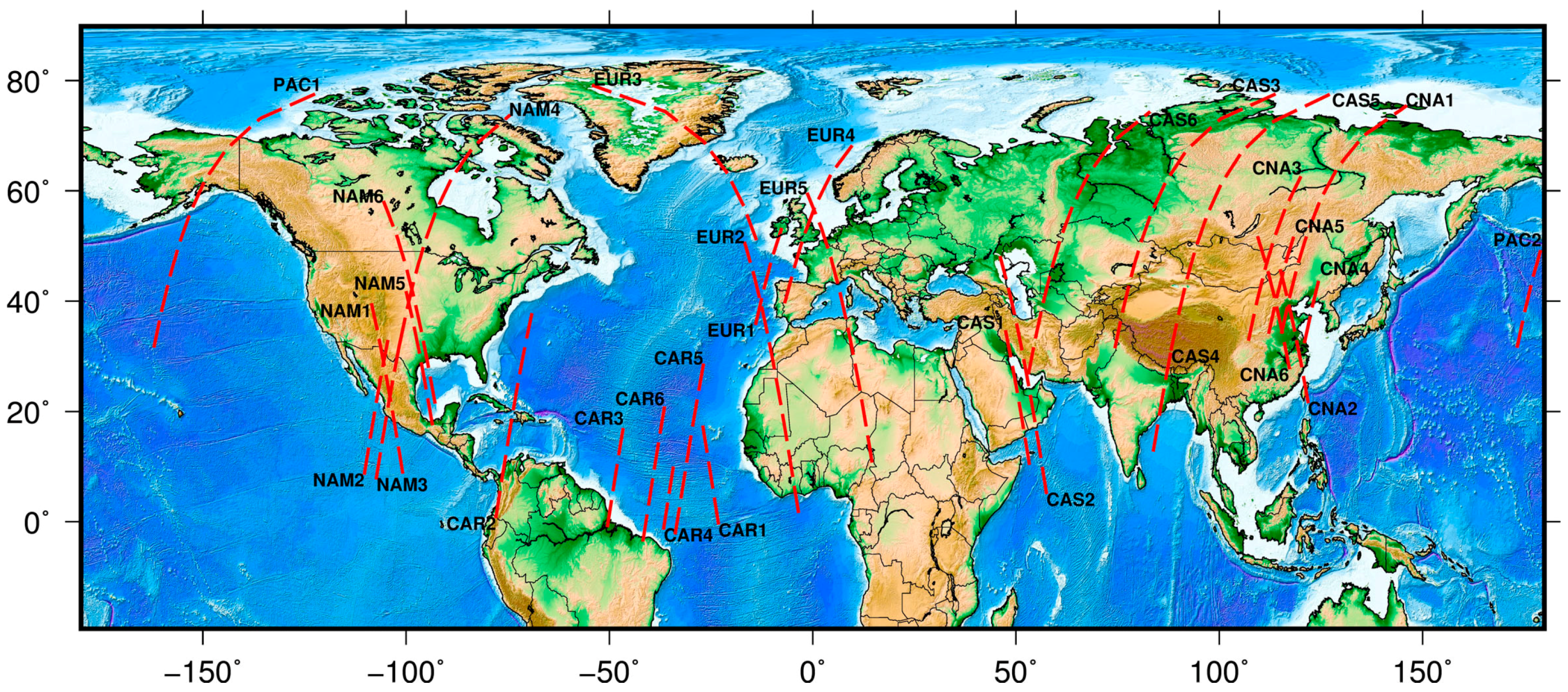
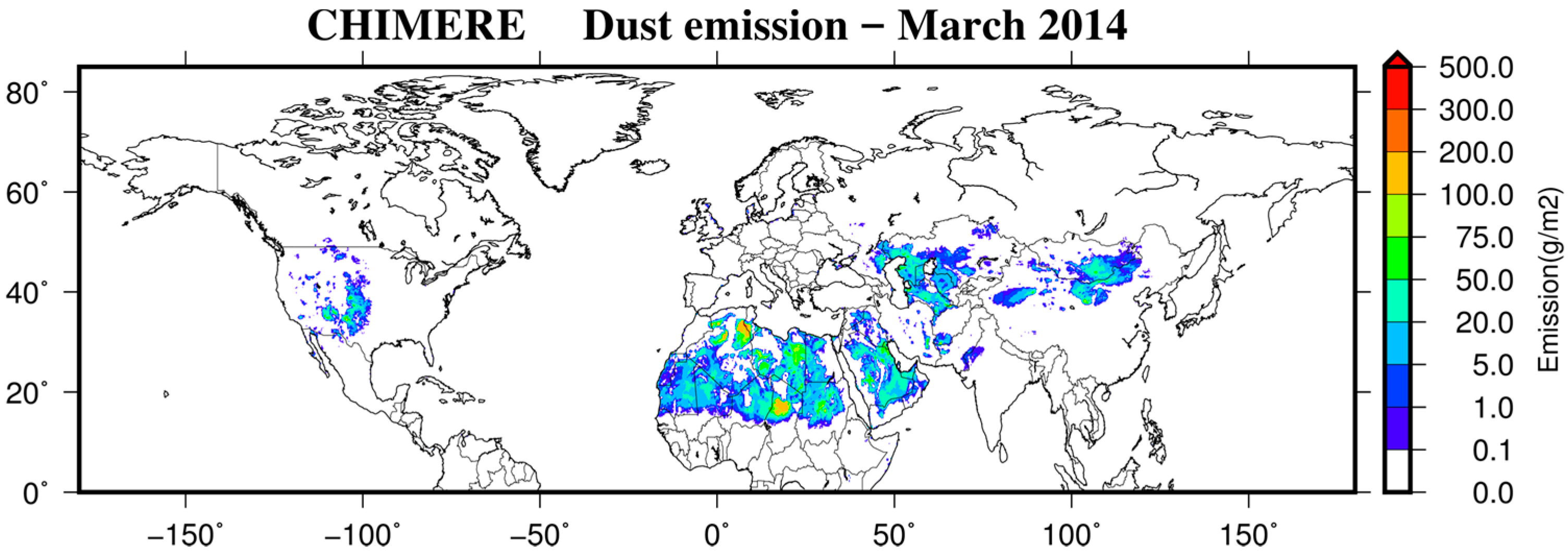

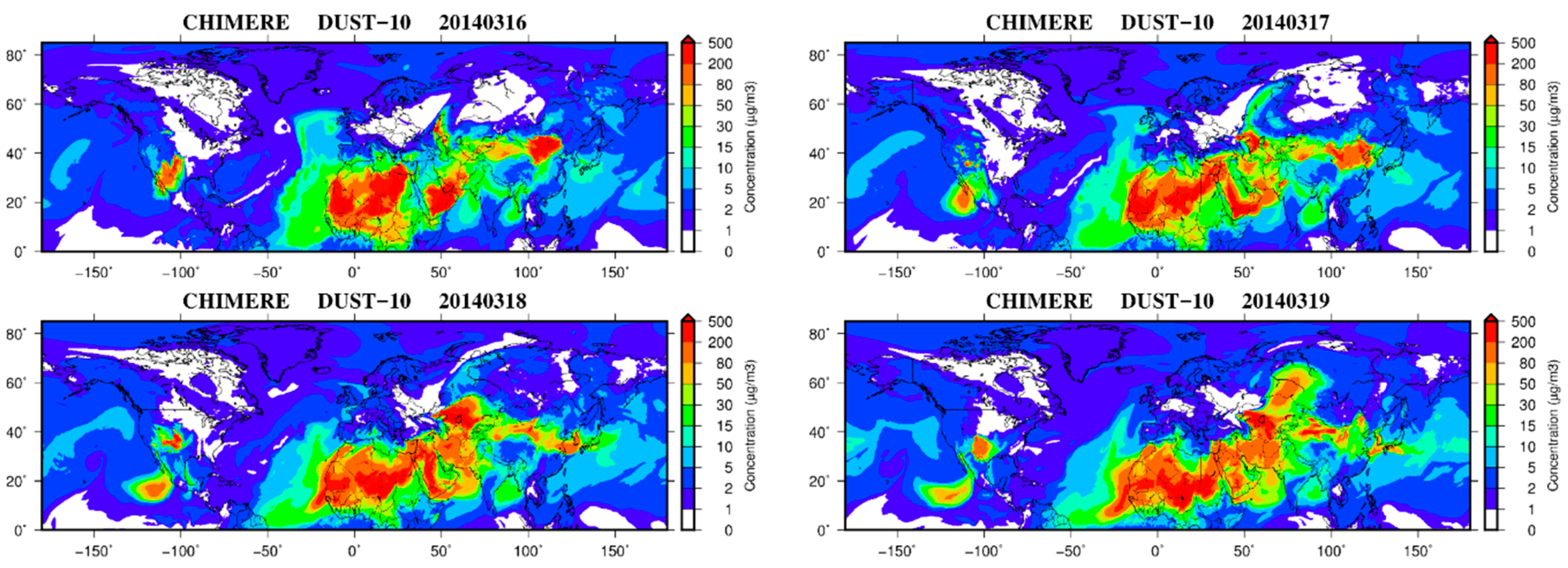

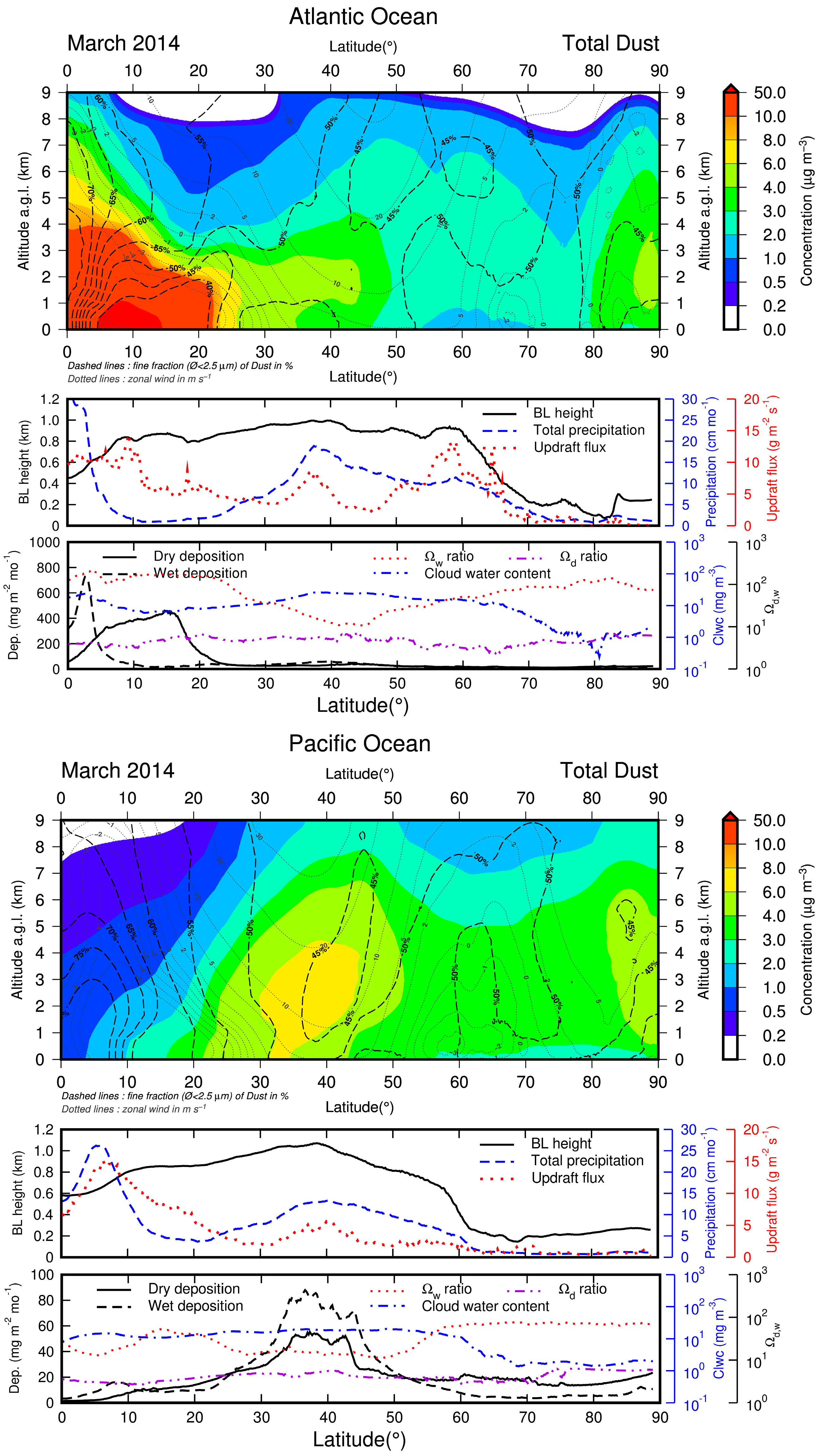
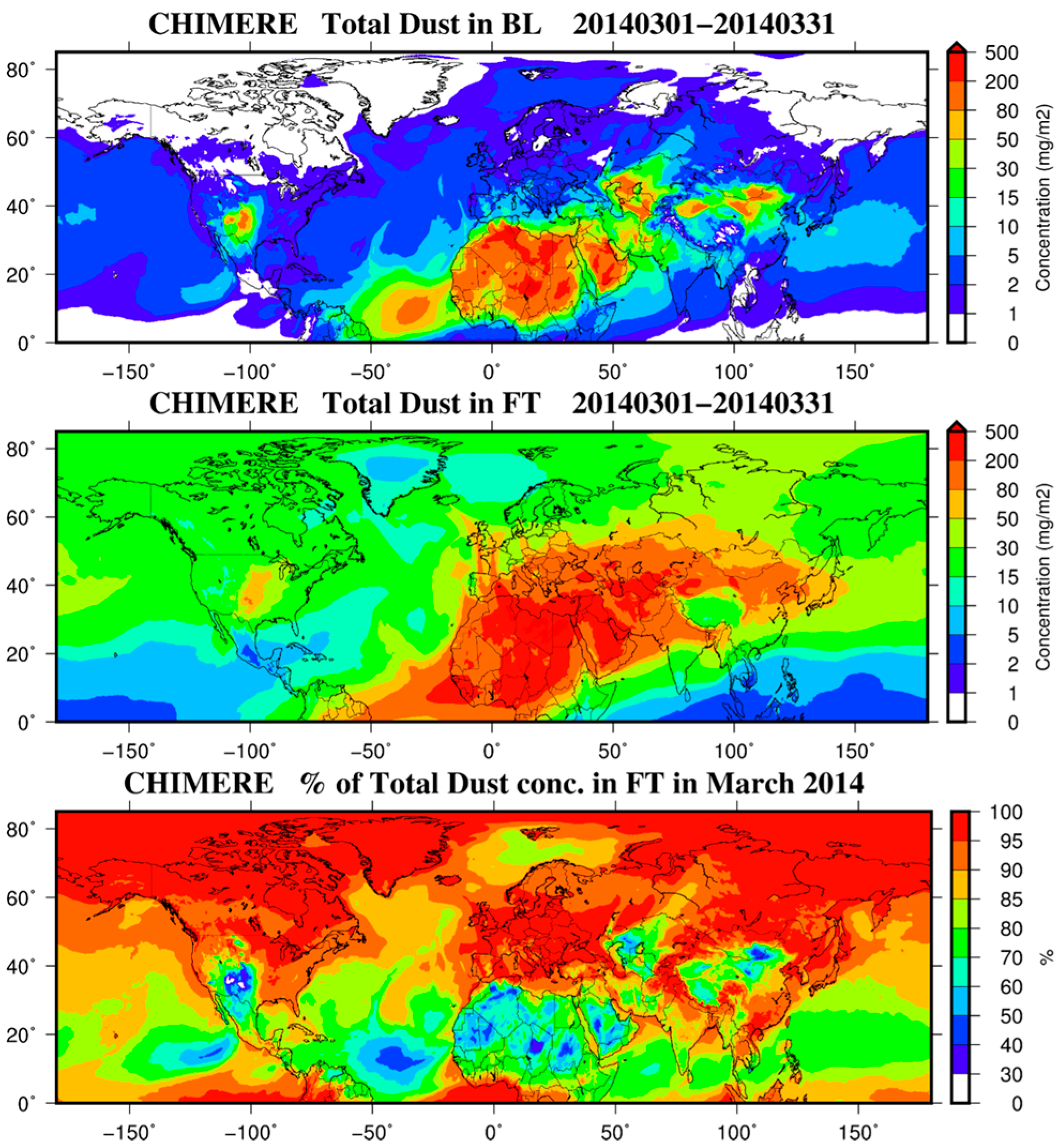
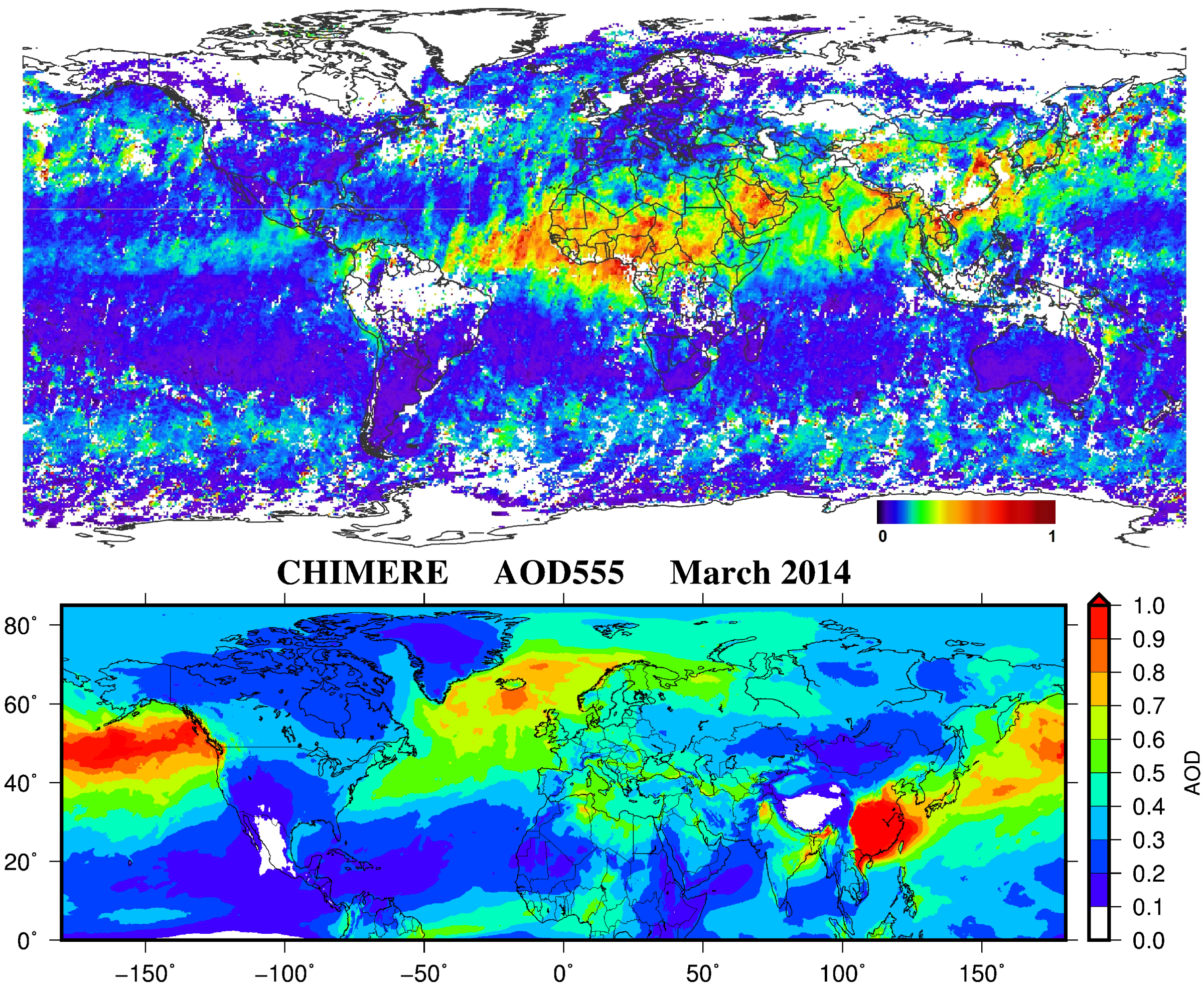
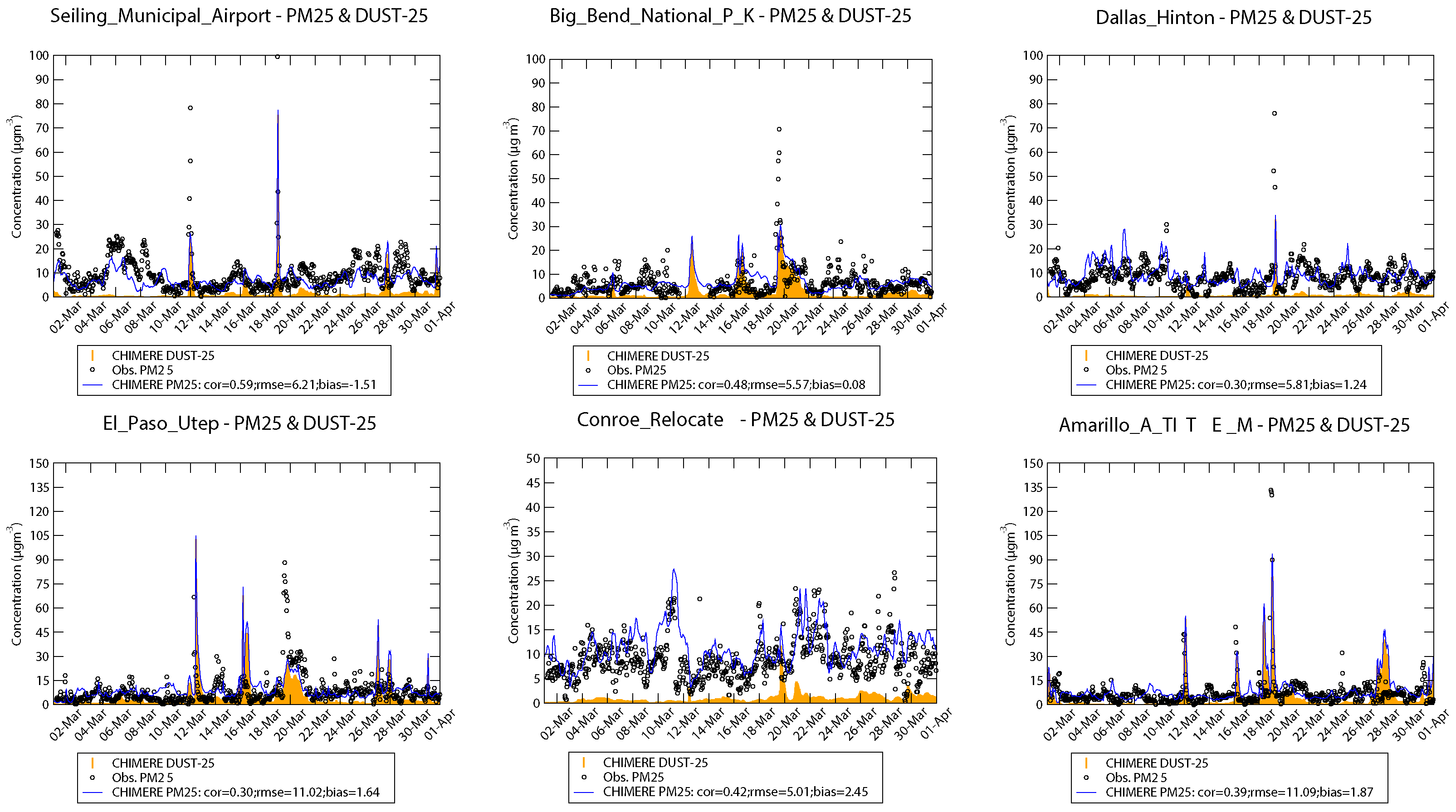
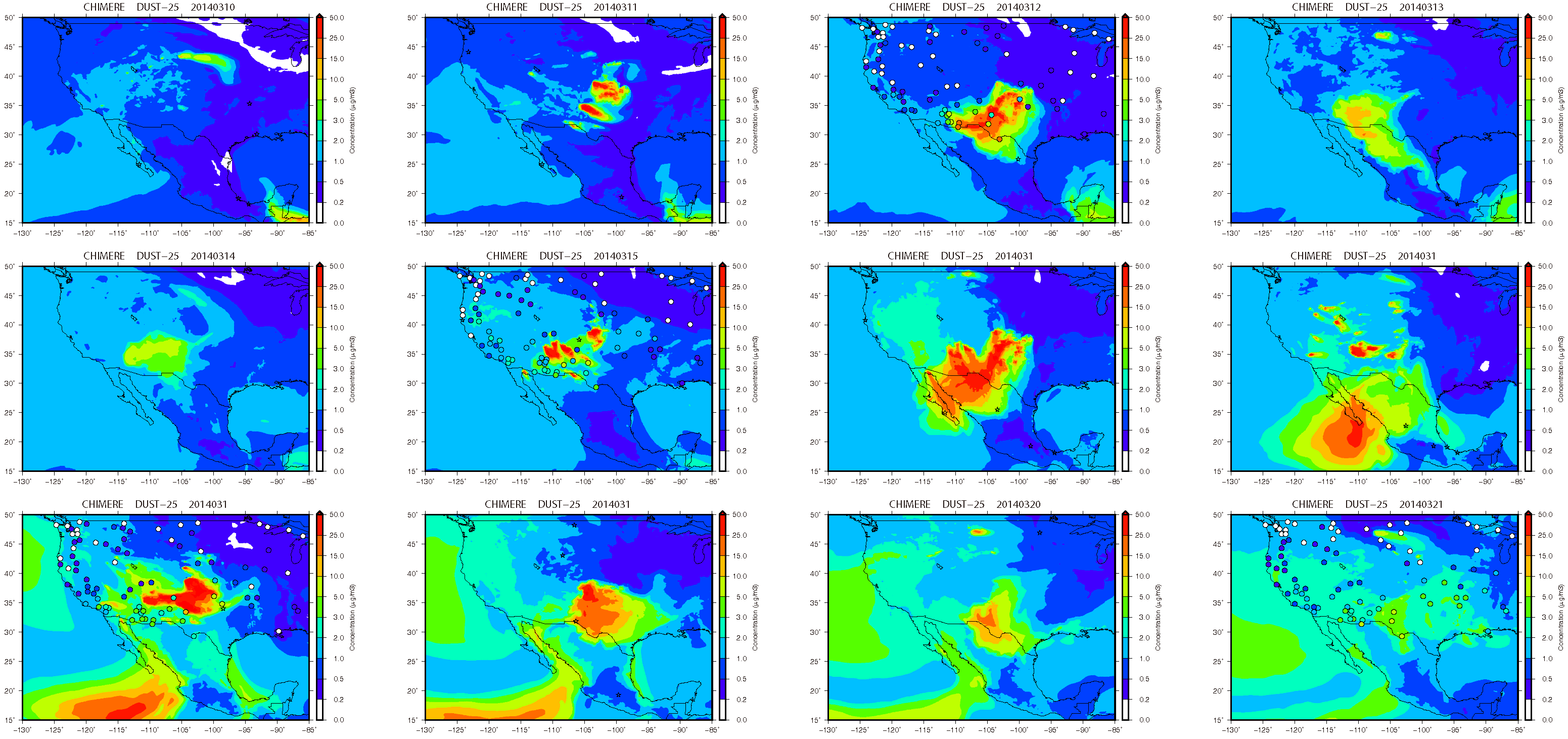
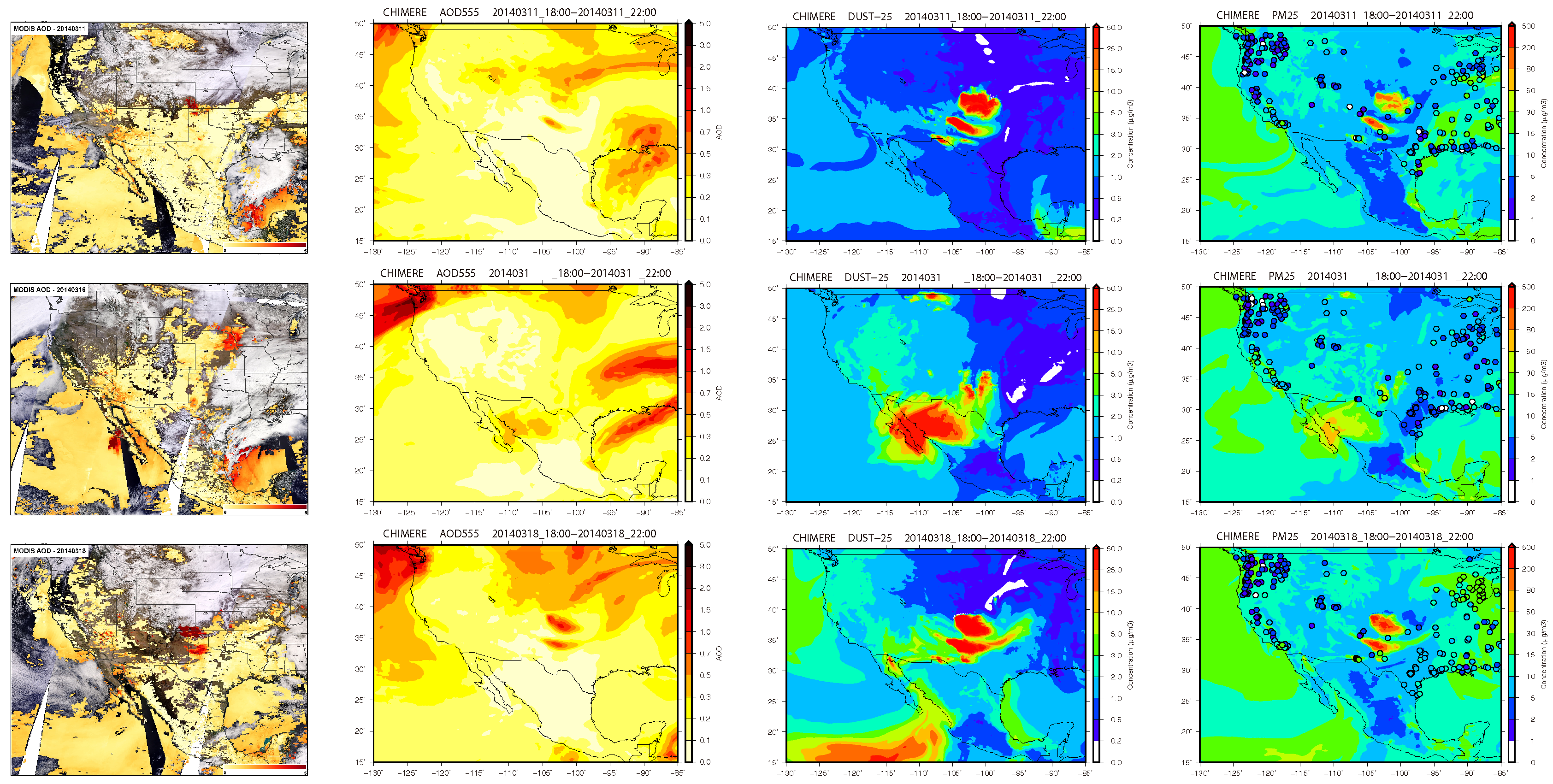
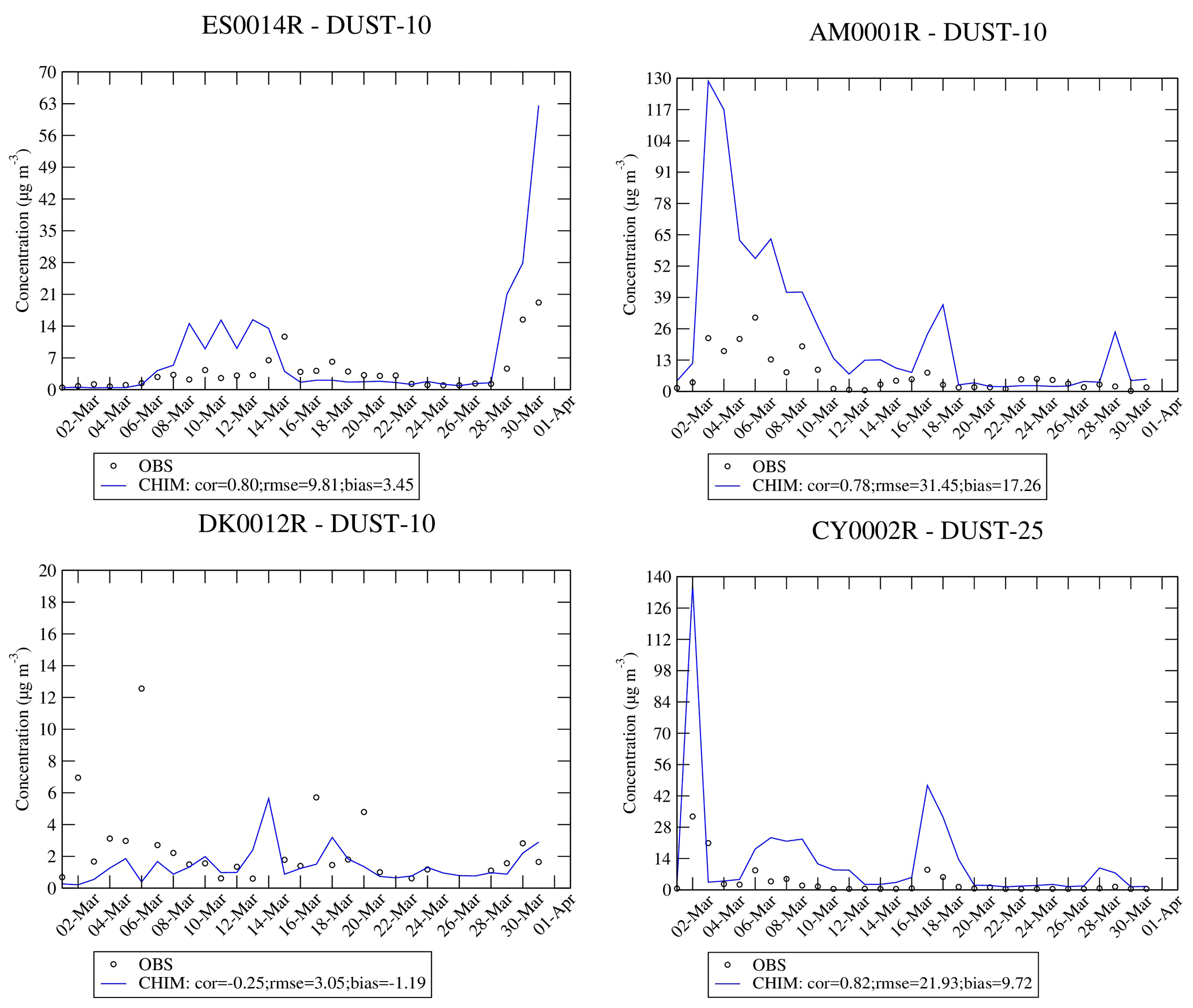
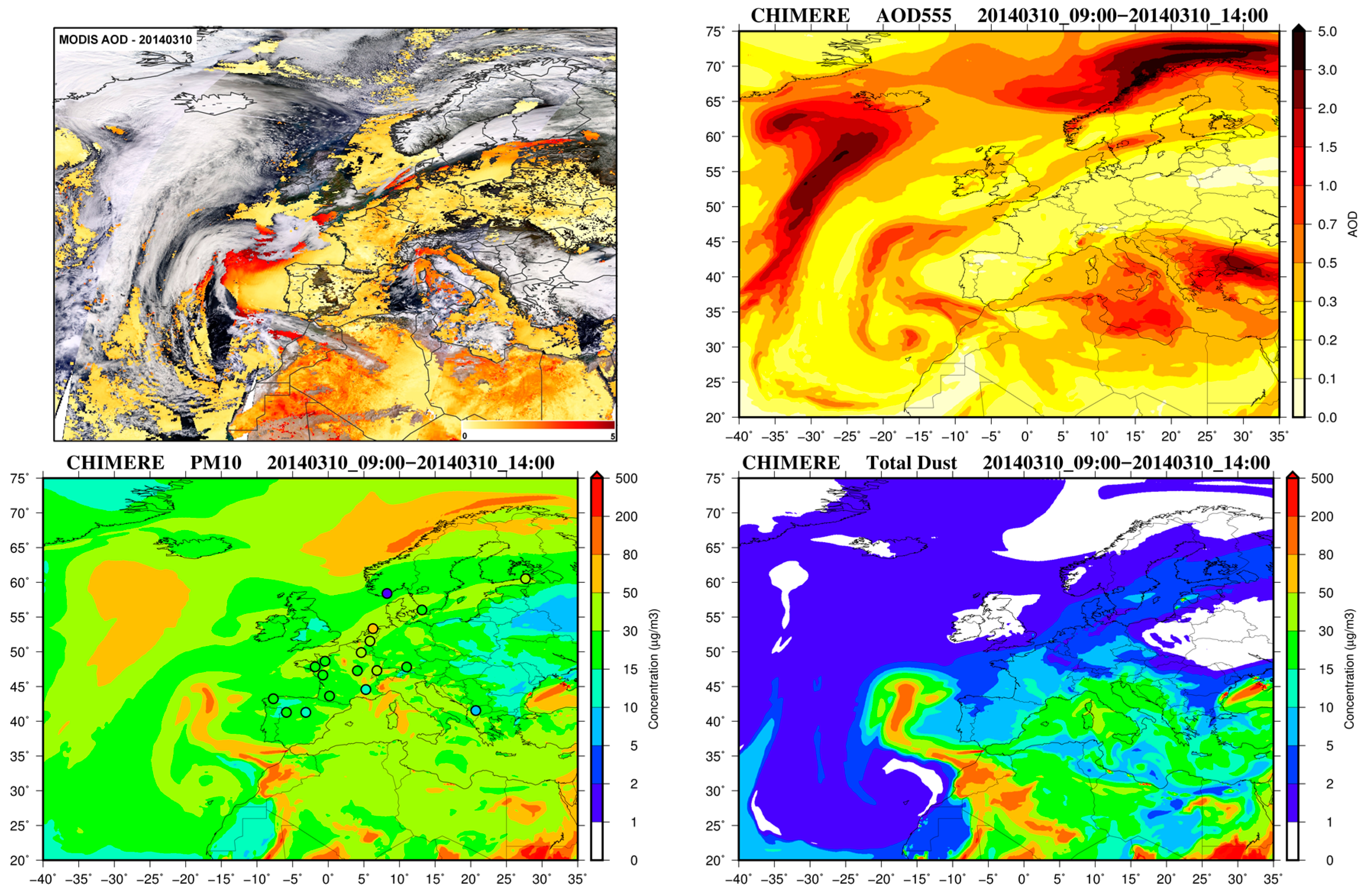

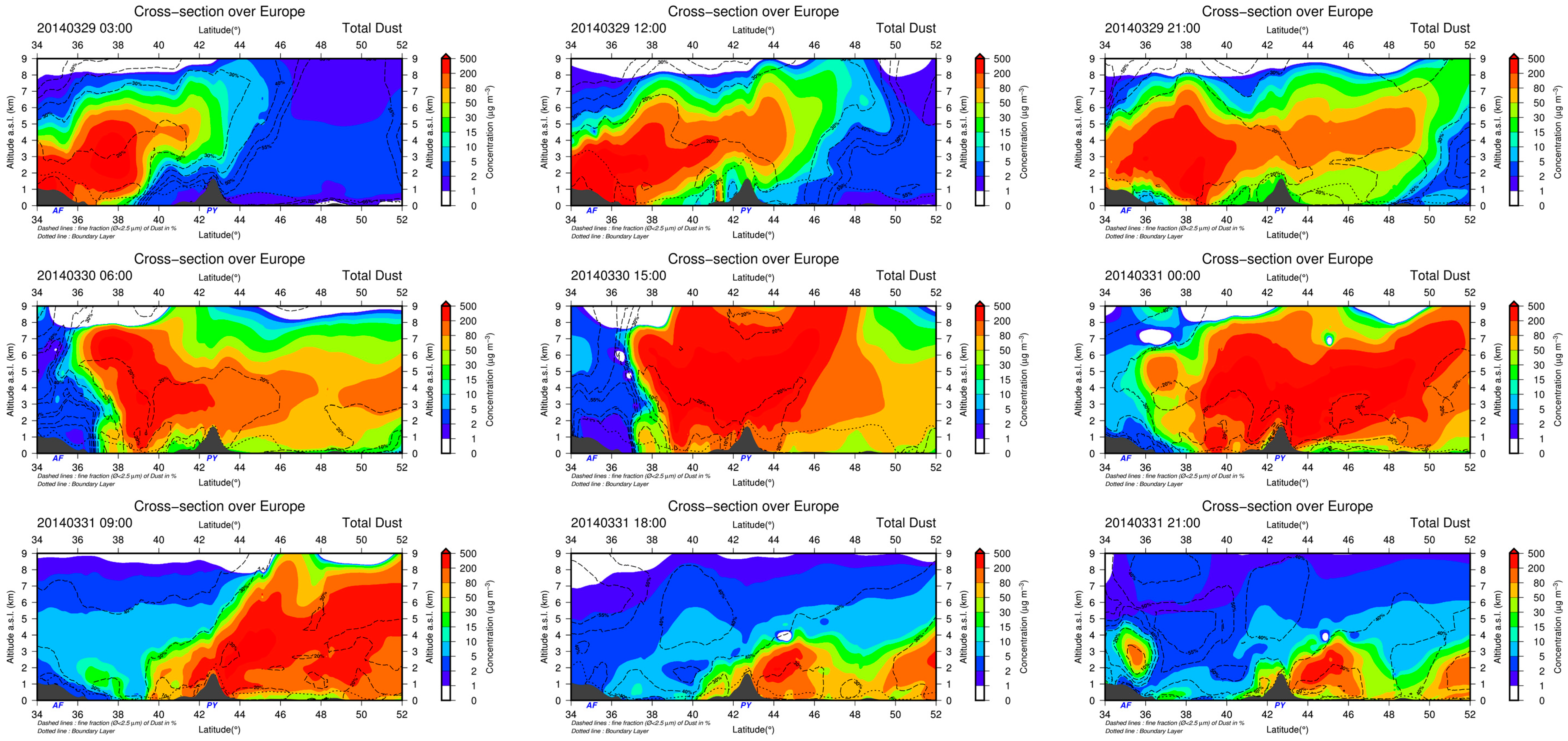
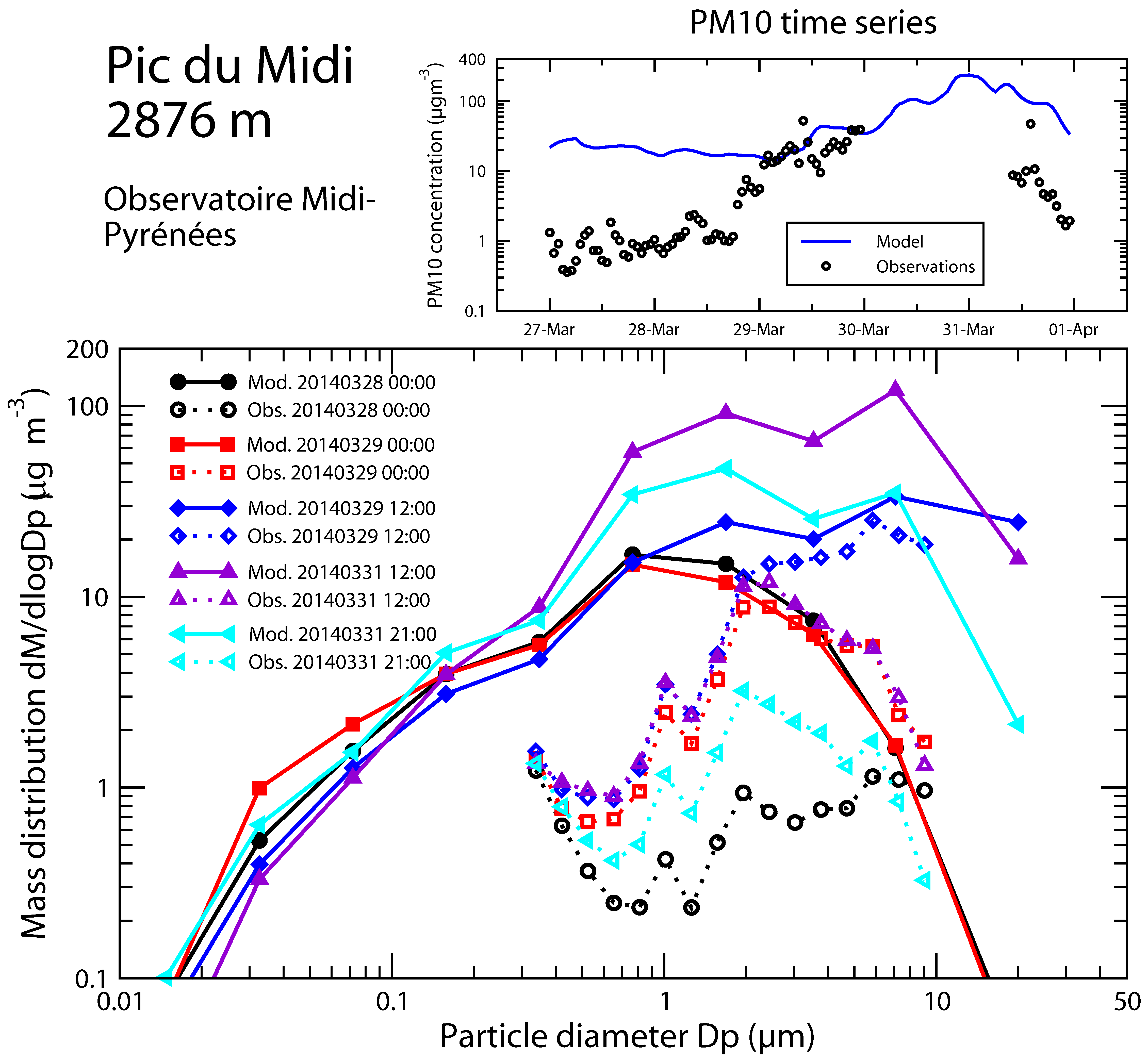



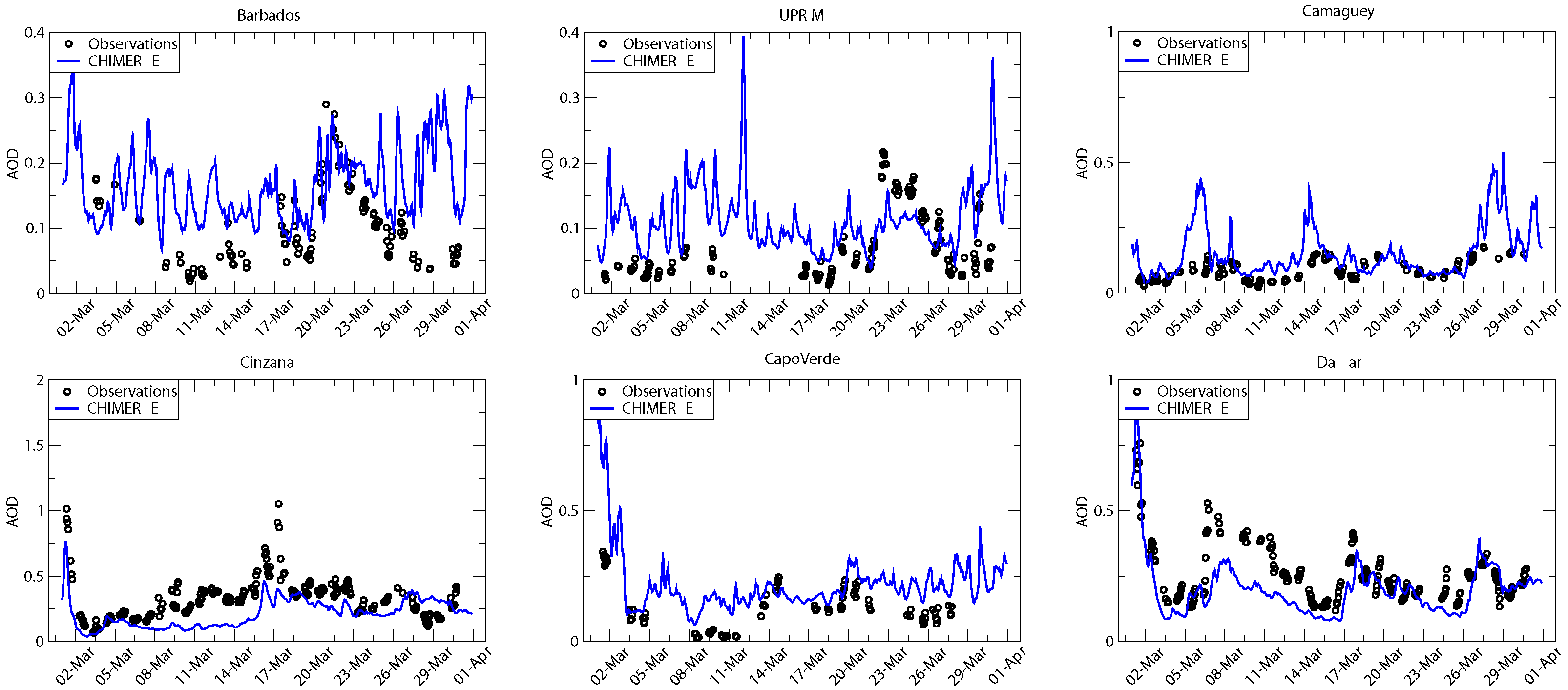
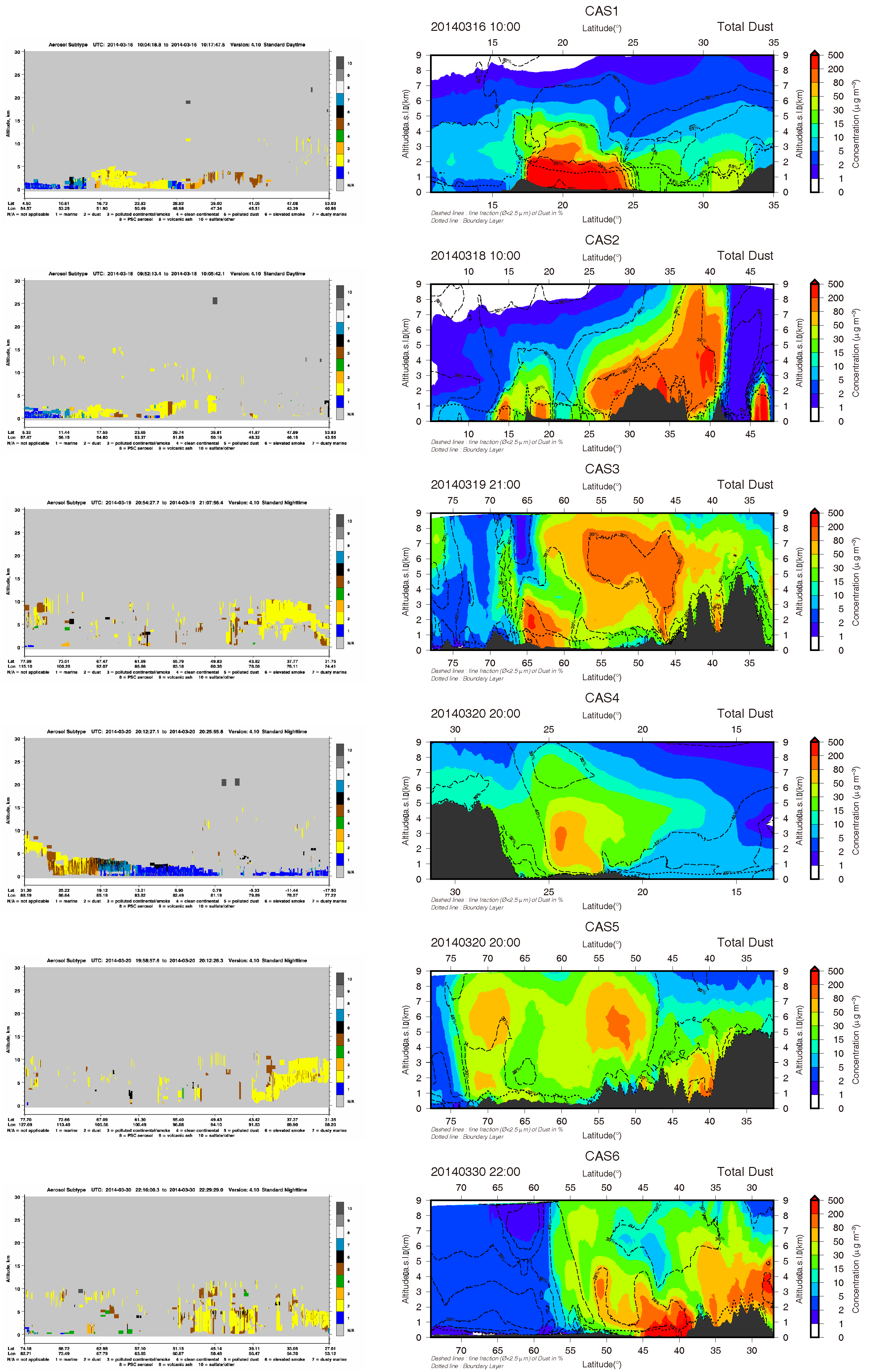
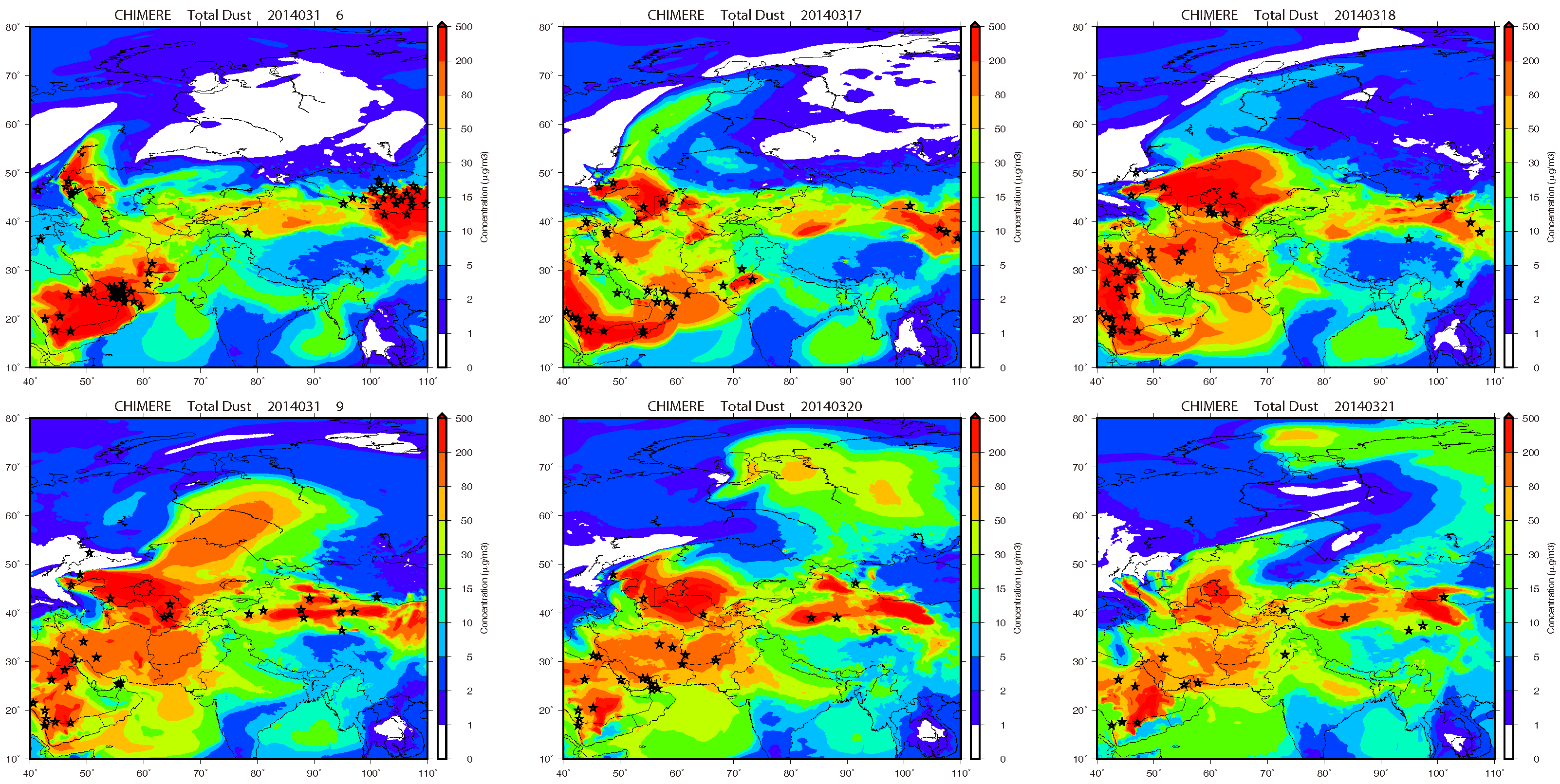
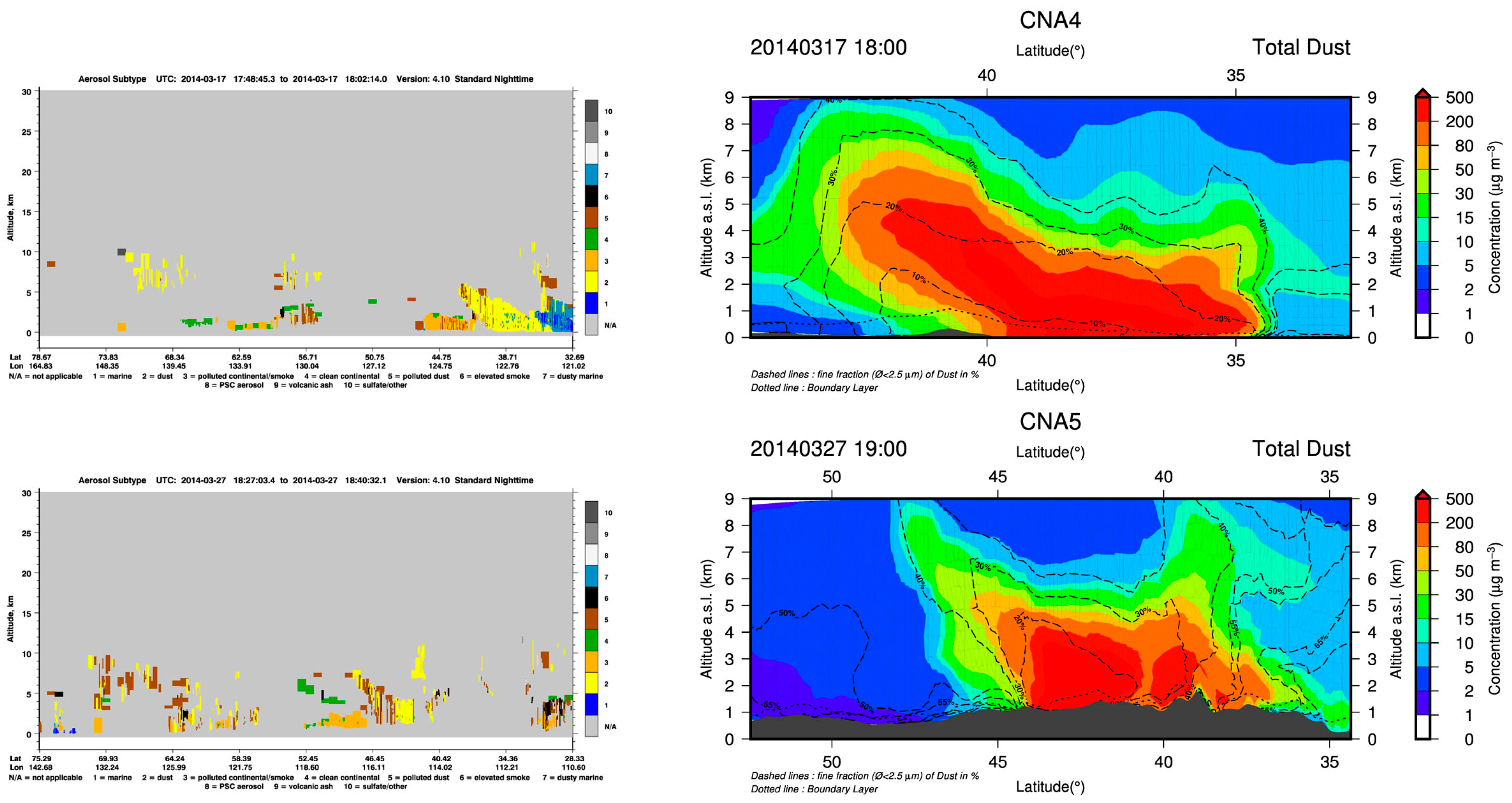
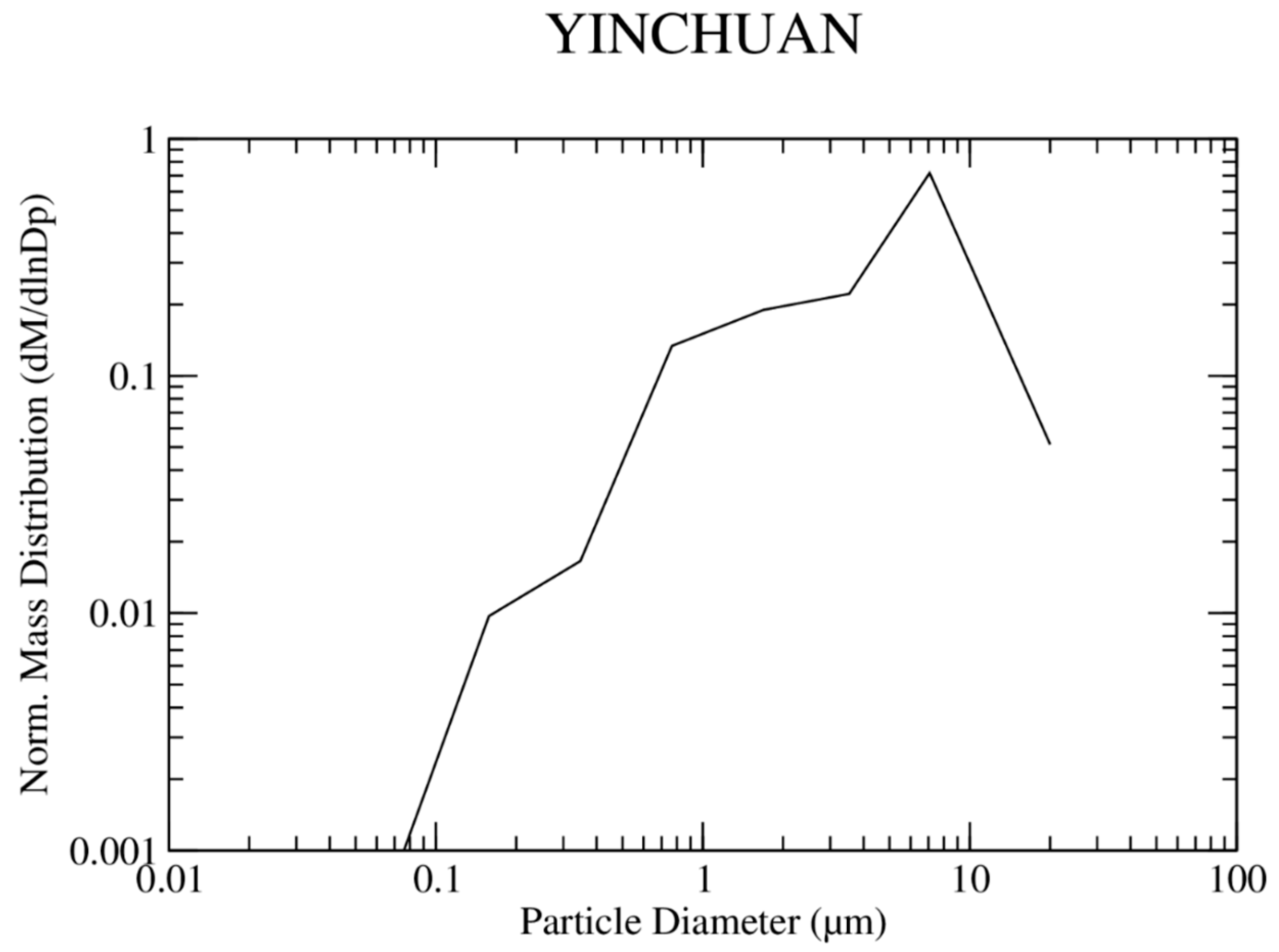
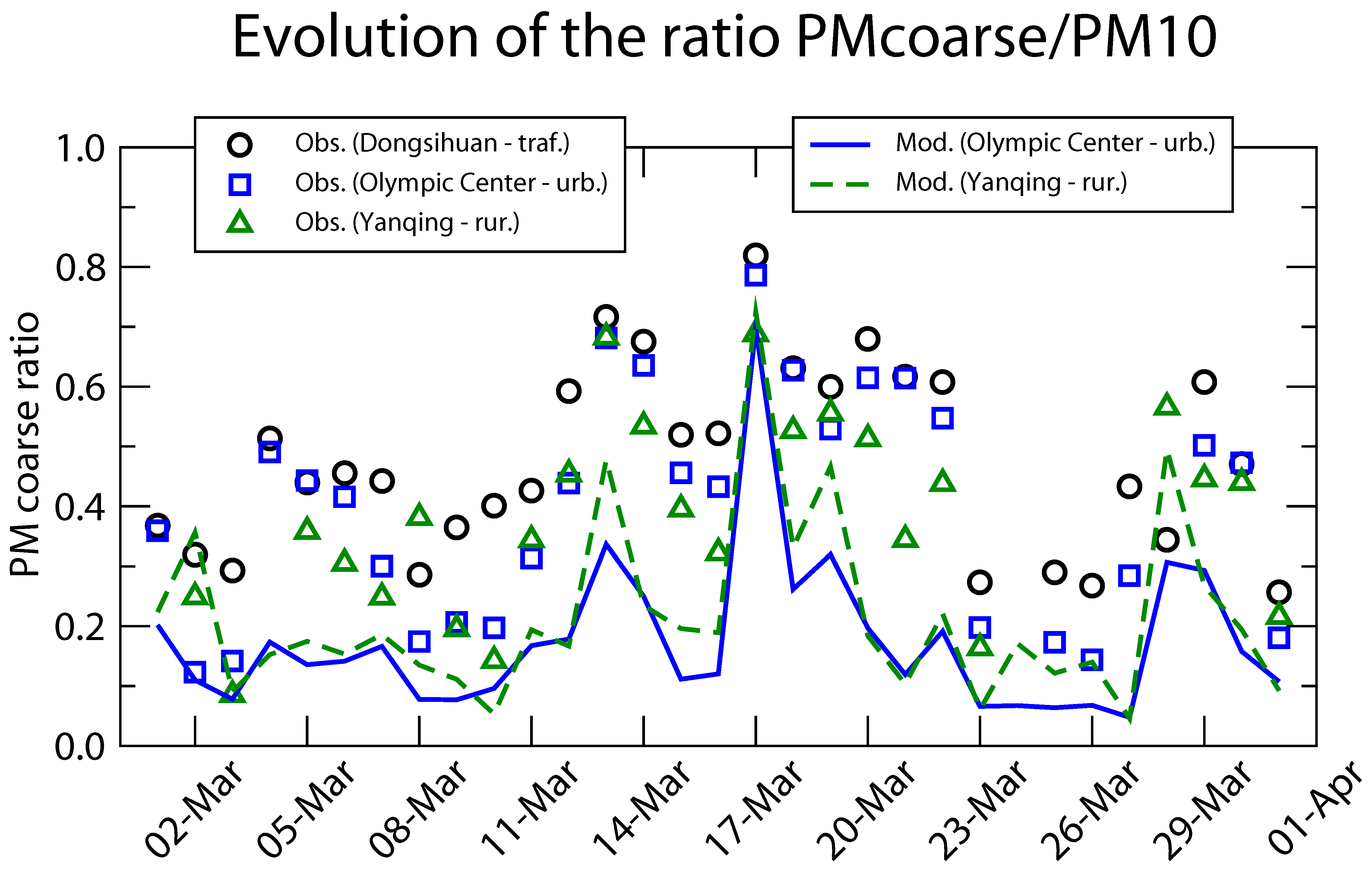
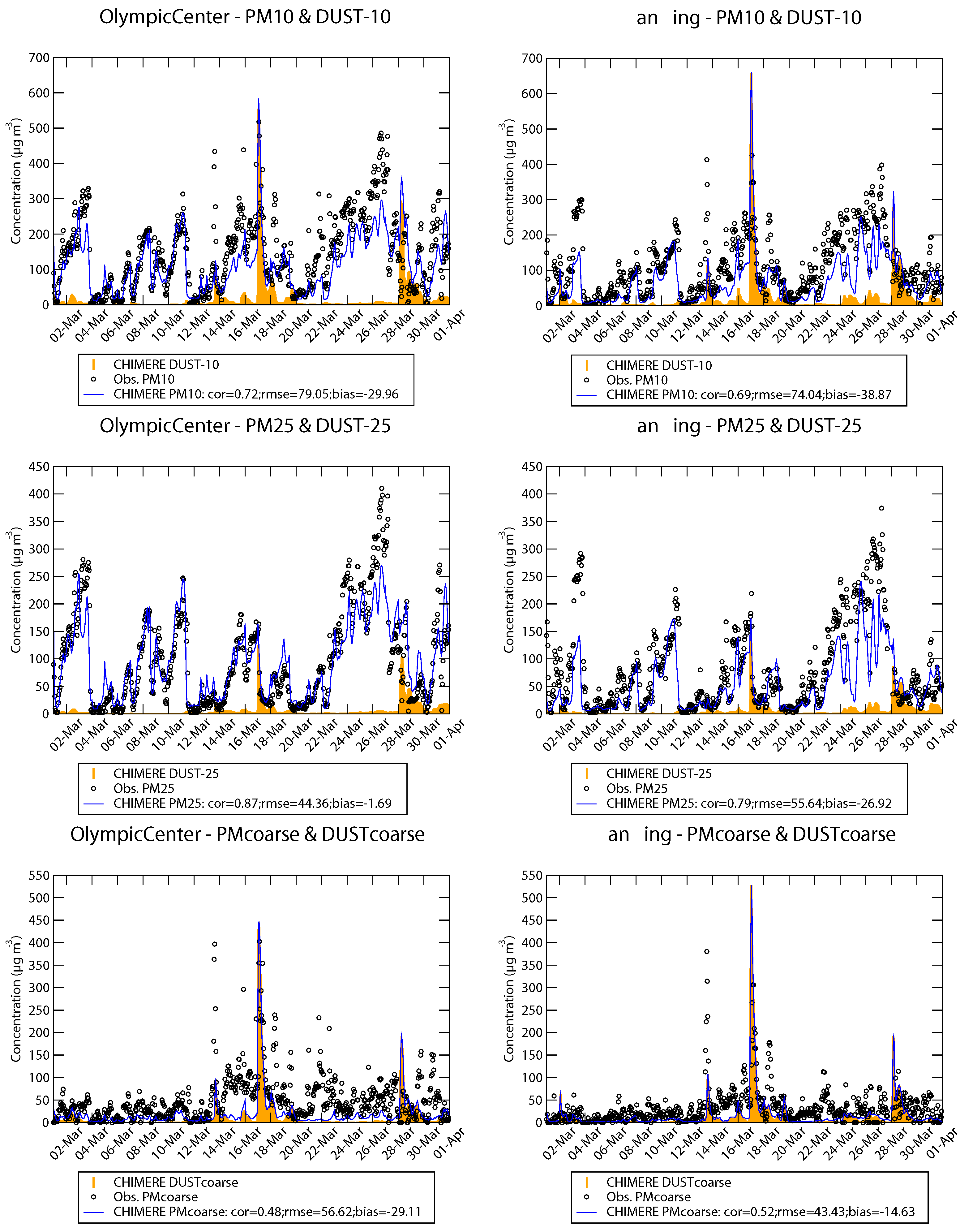
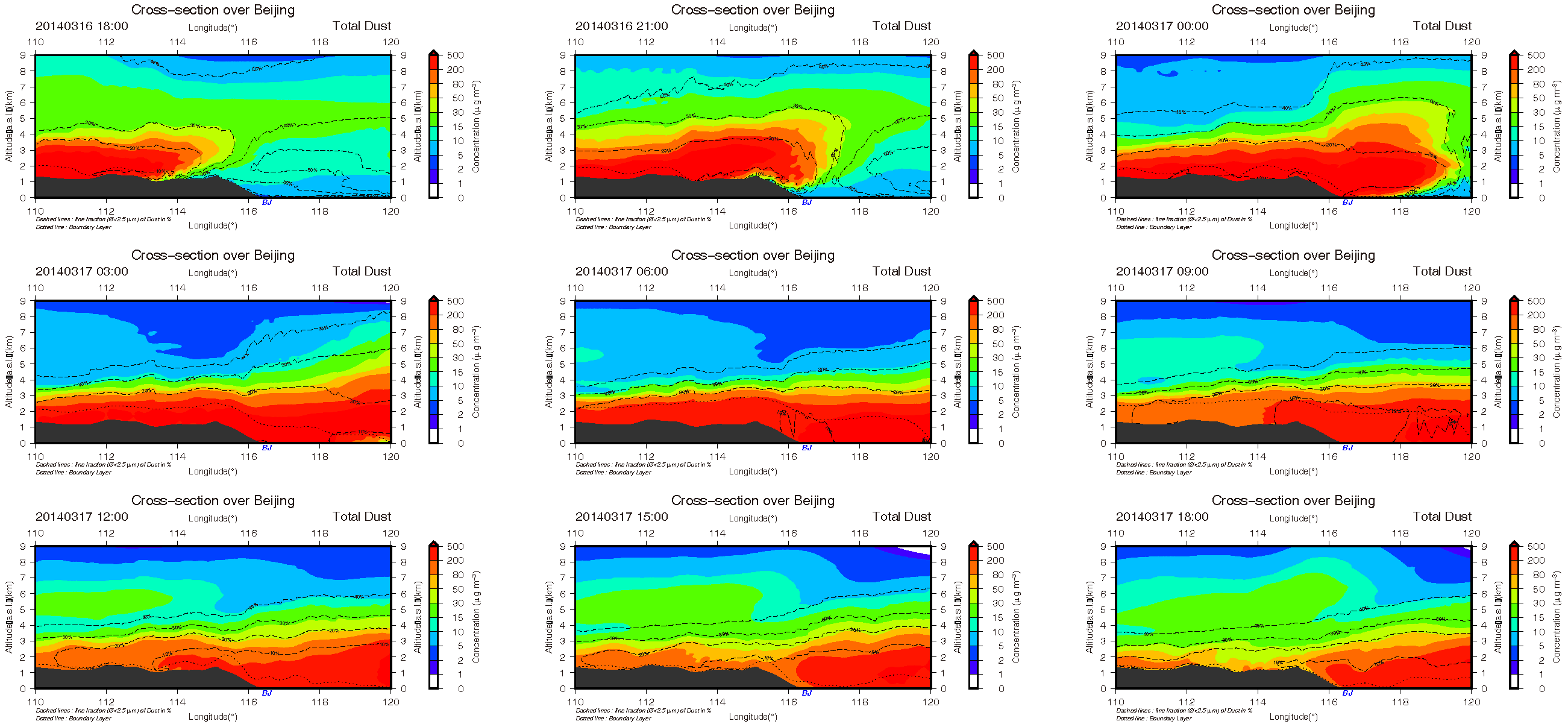
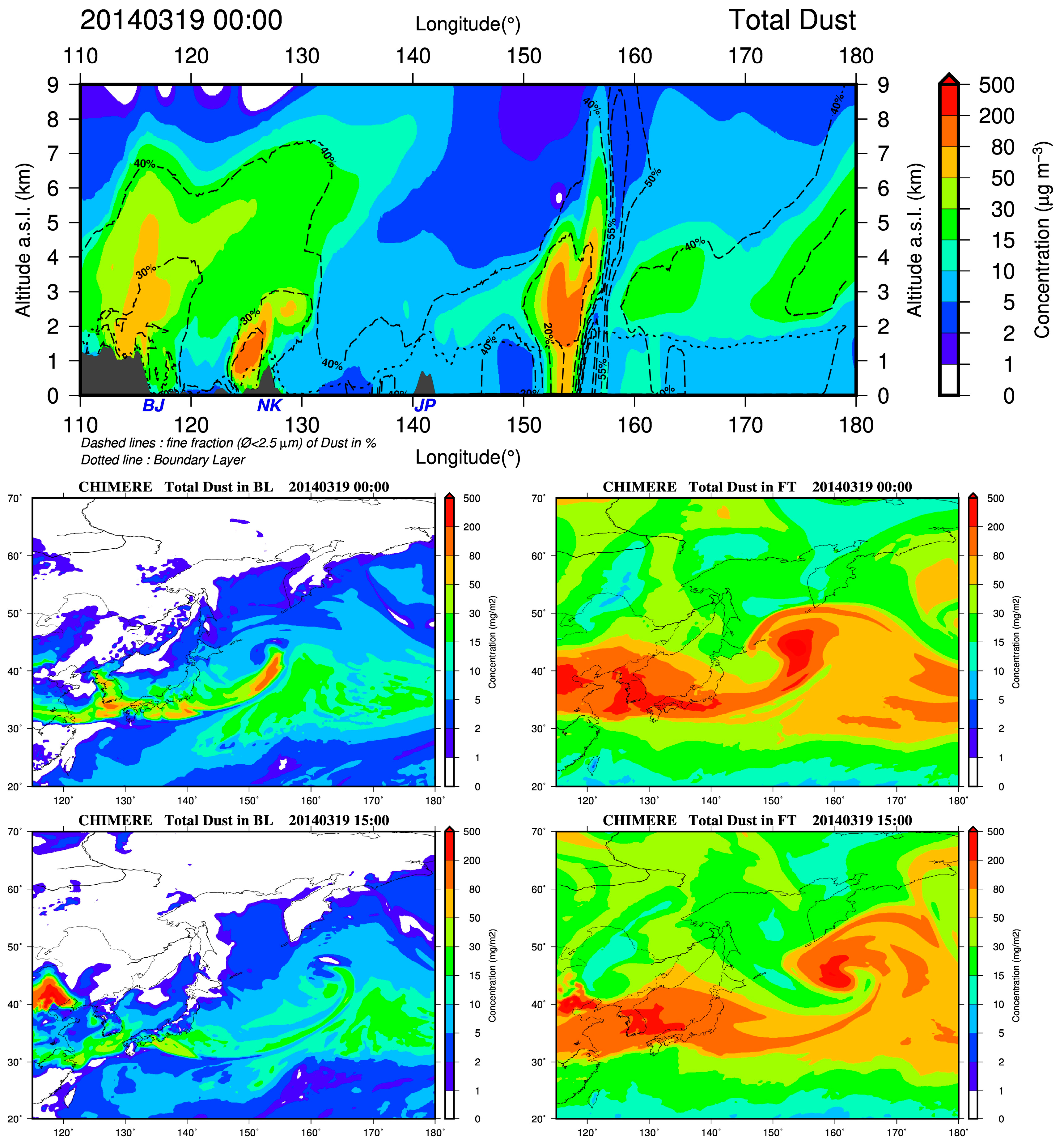
| Domain | Obs. µg m−3 | Mod. µg m−3 | RMSE * µg m−3 | Cor † | Total Number of Daily Data | Spatial Correlation ‡ (Data Points Per Month) |
|---|---|---|---|---|---|---|
| Beijing | 89.9 | 91.8 | 30.9 | 0.91 | 1030 | 0.75 (34) |
| Europe | 20.9 | 13.3 | 11.7 | 0.69 | 1037 | 0.86 (34) |
| USA | 13.3 | 8.1 | 8.4 | 0.30 | 12,953 | 0.04 (367) |
| Date | Observations | Model | ||||
|---|---|---|---|---|---|---|
| µg m−3 | % | µg m−3 | % | |||
| PM2.5 | PM10 | PM2.5/PM10 | PM2.5 | PM10 | PM2.5/PM10 | |
| 26 March | 6.5 | 11 | 60 | 21 | 25 | 85 |
| 27 March | 8.7 | 13 | 67 | 25 | 29 | 85 |
| 28 March | 8.4 | 14 | 60 | 19 | 22 | 86 |
| 29 March | 13 | 23 | 57 | 21 | 25 | 84 |
| 30 March | 17 | 30 | 57 | 30 | 43 | 69 |
| 31 March | 17 | 42 | 40 | 90 | 185 | 48 |
© 2017 by the authors. Licensee MDPI, Basel, Switzerland. This article is an open access article distributed under the terms and conditions of the Creative Commons Attribution (CC BY) license (http://creativecommons.org/licenses/by/4.0/).
Share and Cite
Bessagnet, B.; Menut, L.; Colette, A.; Couvidat, F.; Dan, M.; Mailler, S.; Létinois, L.; Pont, V.; Rouïl, L. An Evaluation of the CHIMERE Chemistry Transport Model to Simulate Dust Outbreaks across the Northern Hemisphere in March 2014. Atmosphere 2017, 8, 251. https://doi.org/10.3390/atmos8120251
Bessagnet B, Menut L, Colette A, Couvidat F, Dan M, Mailler S, Létinois L, Pont V, Rouïl L. An Evaluation of the CHIMERE Chemistry Transport Model to Simulate Dust Outbreaks across the Northern Hemisphere in March 2014. Atmosphere. 2017; 8(12):251. https://doi.org/10.3390/atmos8120251
Chicago/Turabian StyleBessagnet, Bertrand, Laurent Menut, Augustin Colette, Florian Couvidat, Mo Dan, Sylvain Mailler, Laurent Létinois, Véronique Pont, and Laurence Rouïl. 2017. "An Evaluation of the CHIMERE Chemistry Transport Model to Simulate Dust Outbreaks across the Northern Hemisphere in March 2014" Atmosphere 8, no. 12: 251. https://doi.org/10.3390/atmos8120251



